By Lindsey Walker • December 5, 2025
Lindsey has been a key contributor to this site for nearly a decade. After six extensive trips to Greece covering everything from the busiest islands to the quietest mountain villages, she has mastered the logistics of Greek travel. Here are her favorite destinations, essential tips, and hard-won lessons from the road.
Lindsey’s Favorite Hotels in Greece
• Athens: Ergon House
• Milos: Milos Breeze
• Santorini: Kivotos
• Crete (Chania): Casa Delfino
• Crete (Heraklio): GDM Megaron
• Rhodes: Kókkini Porta Rossa

My first trip to Athens in 2018.
Greek Travel – My Advice
- After nine years writing for SD and traveling through Greece and beyond, I’ve learned what’s worth your time and what you can skip, plus tips for a smooth journey. This guide is my personal shortlist; at times, it differs from other recommendations on this site, some of which were collaborative efforts. It covers the highlights of Athens, Santorini, Milos, Crete, and Rhodes, plus the practical details: how to move between islands, where to stay, and what to eat when you get there.
- Book hotels early, about 4 to 6 months in advance. This is especially helpful for staying in Santorini, where the location and view are paramount. Most hotels in all of these places (except Athens) are small, boutique hotels with only a few rooms. Booking early ensures you get the best room or suite for your travel needs and budget.
- Ferries link all islands in summer. Book on FerryHopper.com for schedules and seats. Arrive 45 minutes to one hour early when traveling through Piraeus Port. This is Athens’ main port, and it’s huge. You want to have plenty of time to find your boat. For the smaller islands and smaller ports, 30 minutes early should be sufficient. Most ferry ports don’t have many shady spots to wait for boats, so wear sunscreen (I’ve even been known to use an umbrella for an extra layer of sun protection at the ports). Bring snacks for longer ferry trips; food on board is pretty basic. If seas are rough, flights connect Athens to every major island and can save time.
- My suggested itinerary balances downtime, beach time, and museum/landmark time. In general, Greece is an unhurried place, which contrasts with some of my suggested jam-packed sightseeing days. If you want to drop some museums or organized tours in favor of lounging at the beach, strolling along the harbor, or perusing the market stalls, you will still have an amazing time. That said, there are some things that I think would be unwise to skip: a visit to the Athens Acropolis, a Kelftiko boat trip in Milos, a sunset view over the caldera in Santorini, a walk along the Venetian harbor in Chania, a trip to Knossos Palace near Heraklio, and an exploration of the Palace of the Grand Master of the Knights of Rhodes. These are the bare minimum must-sees for your Greek trip.
Paratriking in Chania, Crete. Ever wonder how we get our cool aerial shots?
My 2-Week Itinerary – The Basics
- Athens (Days 1 & 2): Settle in and recover from jetlag. Make it a chill afternoon/evening wandering the streets, have dinner and drinks, and visit Polis Hammam. The next day, take an e-bike tour in the morning to see the city and its incredible sights: the Tower of the Winds, the Presidential Palace, the Panatheniac Stadium, and more. Visit the Acropolis Museum, then hike up to the Acropolis to see the ancient Parthenon and surrounding temples. Do the hike up at the end of the day, after the heat has passed and the crowds have thinned.
- Milos (Days 3 & 4): Day one, drop your bags at your hotel and visit a beach or two: Sarakiniko is a must (even if you just stop for the photos). Fyriplaka and Thiorochio are my other two favorites. In the evening, wander the streets of Plaka and climb to the Venetian Castle for panoramic sunsets followed by dinner and drinks. The next morning, take a half-day sailing trip to the old pirate hideout, Kleftiko, for swimming, snorkeling, and sea cave exploration. Have a seafront dinner in Klima (at Astakas Restaurant) or in Adamas (at O! Hamas!).
Sunset view from Fira, Santorini, with a view toward the caldera and volcano. The view is paramount when choosing a hotel on this island.
- Santorini (Days 5-7): Arrive on the island and settle into your hotel in Fira, Firostefani, Imerovigli, or Oia. Spend the day exploring your caldera village at your own pace, getting lost among the alleys, stairways, and terraces. Stop for a drink with a view, and visit the small shops. Enjoy your first dinner overlooking the sea as the sun goes down (reserve in advance for the best view). On your second morning here, start early with a visit to Ancient Akrotiri, followed by a wine tasting at one of the nearby wineries. In the late afternoon, take a catamaran cruise for swimming and taking in the sights of the cliffs and volcanoes from the sea. Enjoy another sunset from the boat. On your final day, hike the caldera trail from Fira to Oia, one of the most spectacular walks in Greece. End your hike with lunch in Ammoudi Bay and a dip in the sea. In the late afternoon, explore one of the traditional villages. Pyrgos is especially nice in the evenings. End your trip with a dinner at a delightful Greek taverna in one of the villages.
- Crete (Days 8-11): Arrive in Chania and head straight for the harbor; stroll the length from the Venetian fortress to the Ottoman mosque. Wander the picturesque lanes. End the day with a sunset craft beer and food tour. The next day is a beach day. Visit gorgeous Elafonisi or Balos Lagoon, among the best beaches in Greece. Return to Chania for a casual dinner. On your third morning, take time to explore the seafront village. Visit the smaller museums, or take a quick swim in one of the beaches in town. Then take an evening cooking class in a rural kitchen in the White Mountains. Get some rest for the next day (it’s a doozy). Check out of your hotel early, and throw your luggage in the car. Drive east to Knossos Palace (mythical home of King Minos and the Minotaur). After exploring the archaeological site, visit Crete’s wine country for lunch and wine tastings. Finally, head into Heraklio to visit Koules Fortress and have a decadent dinner at Peskesi (reserve well in advance).
- Rhodes (Days 12-14): Fly (skip the ferry) into Rhodes. Stay in the Old Town, a medieval walled city complete with a moat. Spend the first day diving fully into the medieval city’s history. Walk the Street of the Knights up to the Palace of the Grand Master of the Knights of Rhodes. Explore the castle, then take the 1.5 km hike along the top of the city walls. If you’re still energized, take a sunset e-bike tour to see all the main sights that are just a hair too far apart to reach on foot. Enjoy dinner at an open-air restaurant. The next morning, get up early and drive south to Lindos to visit the ancient Acropolis (much smaller than Athens’ Acropolis). Hike up early before the heat of the day settles in, and enjoy the archaeological site with panoramic views over the sea and the whitewashed village. Have lunch in one of the pretty cafes in the village or with toes in the sand in St. Paul’s Bay. Have one last swim either here at St. Paul’s or on the way back to the Old Town (Anthony Quinn Bay and Faliraki Beach are also great choices). On the third morning (Day 14), it’s time to head home. But if you have a late flight or ferry, why not spend the morning at Filerimos Monastery? It’s only 20 minutes to the airport or 25 minutes to the ferry port.
Of course, Santorini’s not the only place with wonderful sunsets. Plaka is the best village in Milos for sunset views.
Athens: Days 1 and 2

The Parthenon is the most important temple in the Acropolis. Visit early in the morning or late in the afternoon to avoid the worst of the crowds.
Most travelers make the mistake of blowing through the city in less than a day on their way to the islands, but Athens rewards travelers who take their time. Between sightseeing stops, relax in a shady square or a street-side café and watch daily life unfold around you. The city’s charm lies in how easily the ancient and modern worlds mix. In one day, you can stand where Socrates taught, view masterpieces that shaped Western art, and enjoy a hearty dinner in a lively neighborhood taverna. Few cities offer such a direct link to history while remaining so full of energy and life.
There is a wealth of historic sites, museums, dining, and nightlife that it would be foolish to skip, especially if you’ve already traveled a long way to get there. And if you have traveled a long way, this is an ideal spot to adjust to the time change and get over your jetlag. If you have a late arrival time, restaurants and shops keep longer hours here than they do in the smaller islands, so it’s easy if you need to late-night shop for that power adapter you forgot to pack or take in a midnight meal.
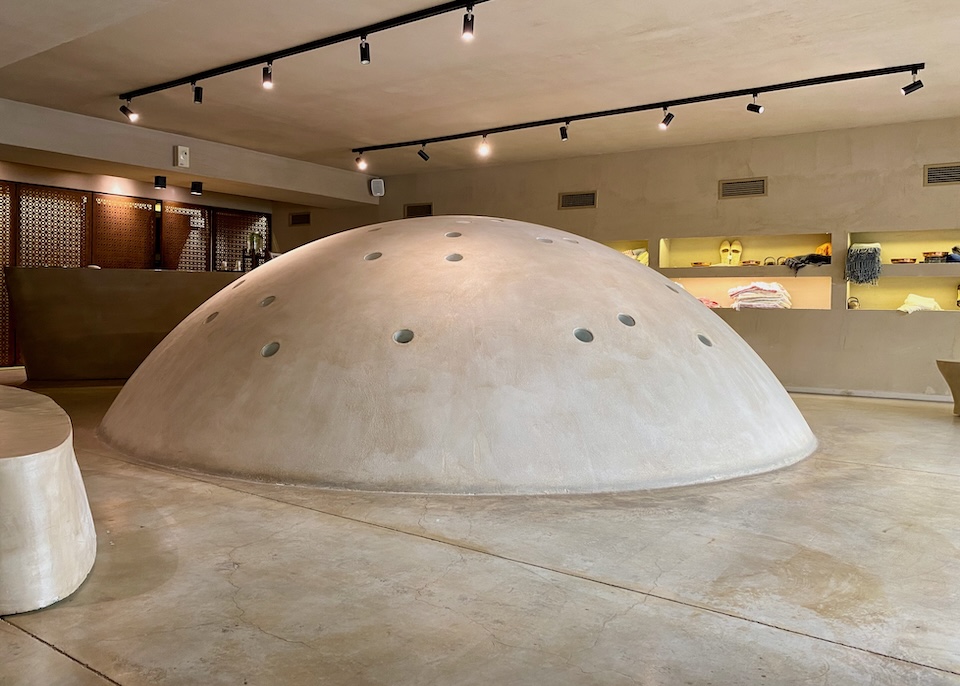
Inside the lobby of Polis Hammam. Hammams (or Turkish baths) were introduced to Greece during the Ottoman Era and remain popular throughout the country. Swimsuits are required for all guests.
One of my favorite things to do when I arrive in Athens too late to enter any historic sites is to visit the spa at Polis Hammam for one of their hydrotherapy packages, which blends Ancient Greek, Roman, and Ottoman healing traditions. The spa is open until 11 p.m. every night, so it’s perfect to wind down after a long day of traveling and get rejuvenated for the days ahead. Perfect first-night itinerary for late arrivals: Relax at Polis Hammam, walk right next door to Ristorante Atlantikos for dinner (open until 1 a.m.), pass through Little Kook to see the lights and maybe grab a sweet treat (open until midnight), have a nightcap at Juan Rodriguez Bar (open until 2 a.m.) When you wake up tomorrow, you’ll be ready for anything.
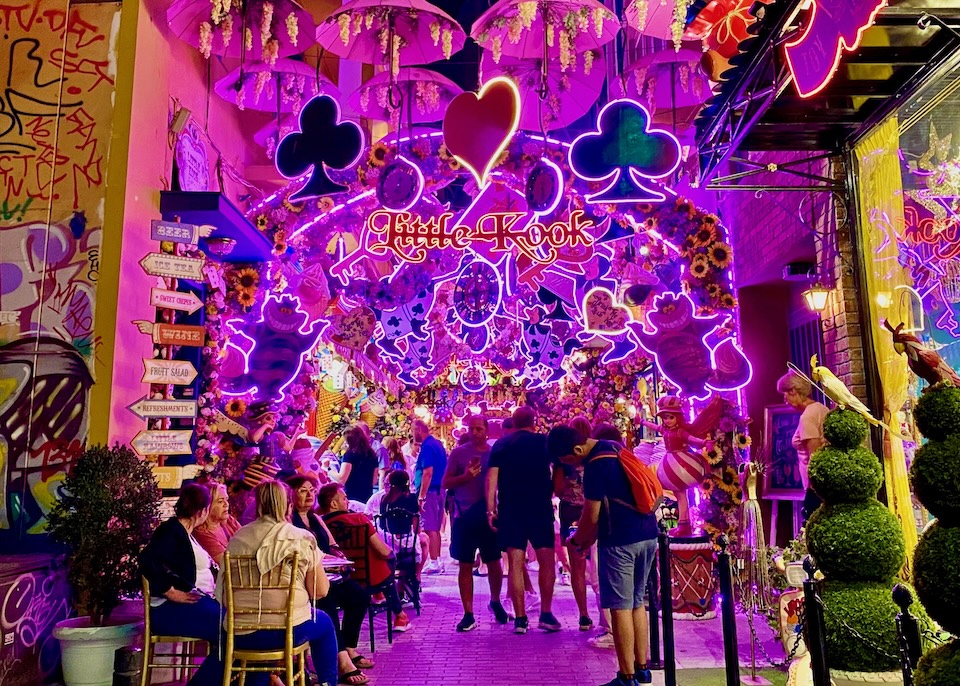
Decorations at Little Kook change seasonally. It’s always fun to see what’s new here.
Of course, the Acropolis is the major attraction here. Early mornings and early evenings (right before closing) are the best times to visit to avoid crowds and beat the heat. On a first morning after a long travel day, I do not set an early alarm, so going first thing in the morning is out of the question. Instead, let’s start with a fun e-bike tour of the city and visit the Acropolis later in the day. This Historic Athens tour is my favorite one. Athens is a super walkable city, but since our time is limited, hopping on an e-bike helps us see the ancient and modern highlights in just a few hours. Plus, it’s super fun! This tour stops by the Presidential Palace, the National Gardens, the Panathenaic Stadium, and more.
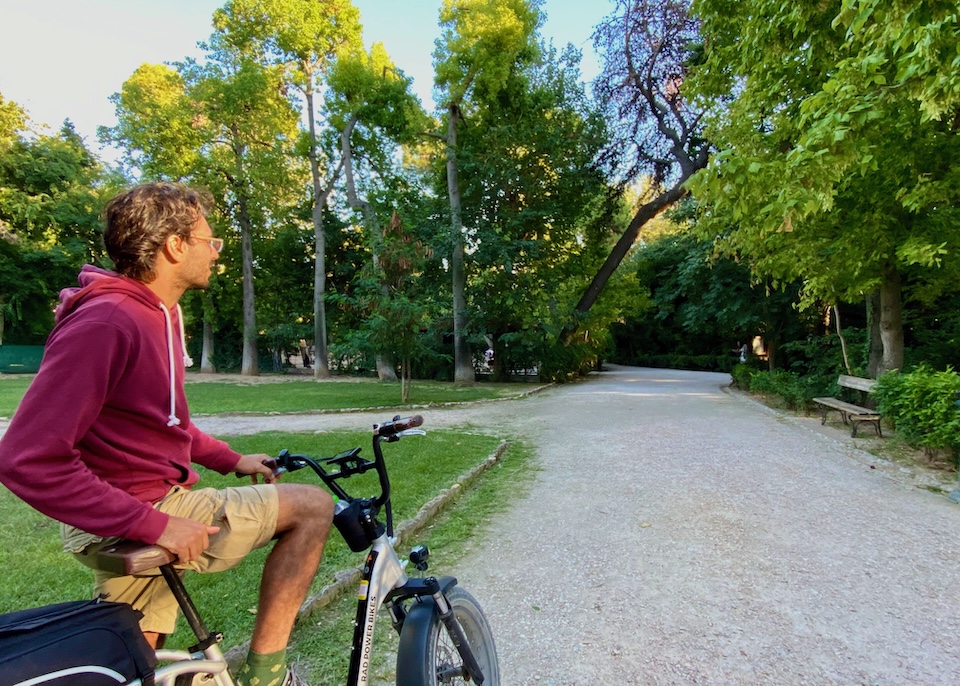
Bike tours are the best way to cover a lot of ground in a short time. This was a short stop in the National Garden, which has a mix of indigenous and exotic plants. Near the Panathenaiko Stadium and the Presidential Palace.

The Roman Agora in the Monastiraki neighborhood. The Tower of the Winds is on the left and the Acropolis is on the hill above.
After the bike tour, grab a quick gyro lunch, then head to the Acropolis Museum. This modern landmark is organized chronologically, beginning with Archaic-era exhibits that predate the Acropolis and ending at the top-floor Parthenon Gallery, designed with the same dimensions and orientation as the temple itself, along with the original marble friezes and direct views of the Parthenon through glass walls. By the way, consider wearing pants to this museum. The entrance has several areas with glass floors and views down into the excavations of an ancient neighborhood. Of course, people on the lower floors also have incredible views up to the people walking above. Buy your ticket online in advance to skip the long line.
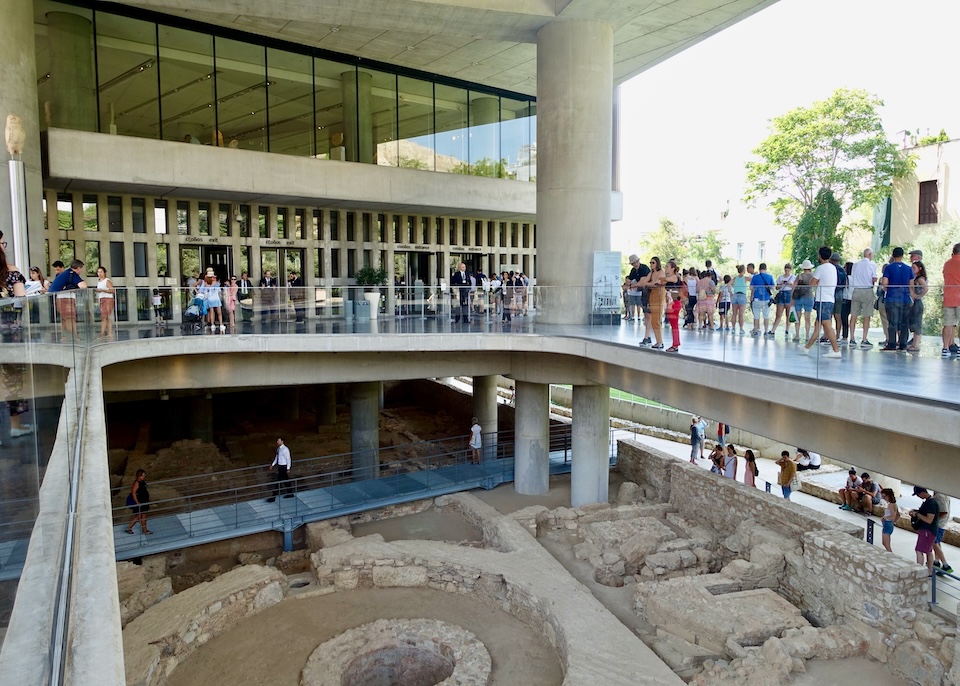
Travelers queue up to enter the Acropolis Museum, which is built above extensive excavations.
And now for the grand finale, the Acropolis, the ancient hilltop citadel that dominates the city’s skyline. Buildings near the ancient site are subject to strict height limits (maximum 21 meters or about five stories) to ensure the city’s jewel is in full view to all nearby. Athens is the birthplace of democracy and the foundation of Western civilization. Nowhere is its history more visible than at the Acropolis. The Parthenon is the centerpiece: an ancient temple to Athena, the single most important surviving structure of Greek antiquity, and among the most recognizable buildings in the world. But there is much more to the site than the Parthenon and a few tumbled-down columns. The monumental gateway to the ruins is breathtaking on its own, and the detail in the hand-carved female figures that make up the Erechtheion Temple’s Porch of the Maidens is incredible. The site includes the ruins of several more temples, sanctuaries, and stoa, with ancient amphitheaters built on the slopes.

The Erechtheion is the most striking temple in the Acropolis complex.
It is well worth your money to join a guided tour or hire a private guide. There is not much signage around the site, and the information provided is very dry. A good guide can thoroughly explain the details – the construction, usage, and significance of the Acropolis and its place in ancient Greek religion and society – in a fun and engaging way. If you opt for a self-guided visit, buy your tickets online in advance and skip the lines at the entrance. This is especially important when going at the end of the day. The Acropolis opens daily at 8:00 a.m. and closes at 8:00 p.m. in summer (last entry at 7:30 p.m.) or at 5:00 p.m. in winter (last entry at 4:30 p.m.)
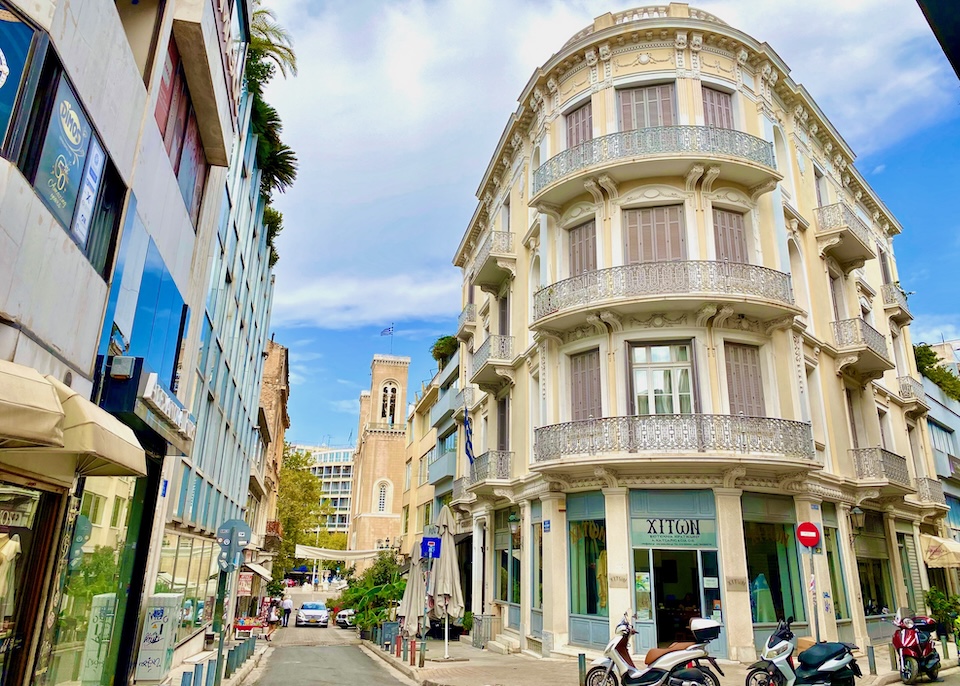
Charming and centrally located, Plaka is one of the best neighborhoods to stay in Athens, especially for a short trip.
Where to Stay: Stay somewhere central to save time traveling to historic sites and attractions. Plaka is the best neighborhood for first-timers (cute, walkable, and right at the base of the Acropolis). Syntagma and Monastiraki are also great choices, both with easy Metro connections to Piraeus port and the airport. These pedestrian-friendly areas are ideal for wandering narrow lanes, browsing shops, and stopping at local tavernas, all while passing by historic landmarks, including the Ancient Agora, Hadrian’s Library, and the Tower of the Winds. My personal favorite hotels here are Ergon House (Syntagma), A77 Suites (Plaka), and A for Athens (right on Monastiraki Square but technically in Psirri.)
Where to Eat: As mentioned, Atlantikos next to Polis Hammam is an excellent spot, known for traditional Greek seafood in a casual setting with outdoor dining. Kostas in Monastiraki has the city’s best gyros, though they use a tomato sauce instead of tzatziki or garlic sauce. Seating is nonexistent, so be ready to take it to go. O Thanasis is a very close second with a more traditional flavor profile and plenty of seating. On a hot, summer night, Ta Karamanlidika Tou Fani is a Byzantine-revival-style deli/taverna combo. I love it for the summer, because most of the dishes are served cold, though they do have some hot meze. They have two locations in Monastiraki and Psirri. For vegan/vegetarian food, Avocado offers exceptional meat-free dishes that are local, seasonal, organic, and sustainable. Open 7 days a week in Syntagma. Also try Falafellas for handheld falafel topped with veggies and (optional) spicy sauce. For something sweet at night head to Little Kook. It’s over-the-top, fairytale-themed (specific themes change seasonally), light-up decorations sprawl across a few intersecting sidewalks. The desserts, cocktails, and coffee drinks are all whimsical sugar bombs that are better for the photo op than they are for eating. But it’s always a blast to visit. For a dessert that’s more focused on flavor, visit Melina Mercouri Cafe in Plaka for baklava or galaktoboureko or try the Greek version of donuts at Loukoumadaki in Psirri.
Best bars: Baba Au Rum (beautifully crafted rum cocktails), Juan Rodriguez Bar (tropical craft cocktails and a late-night kitchen), 360° Cocktail Bar (best rooftop bar with Acropolis views), Bad Tooth (dive bar and live music venue), Heteroclito (best wine bar).
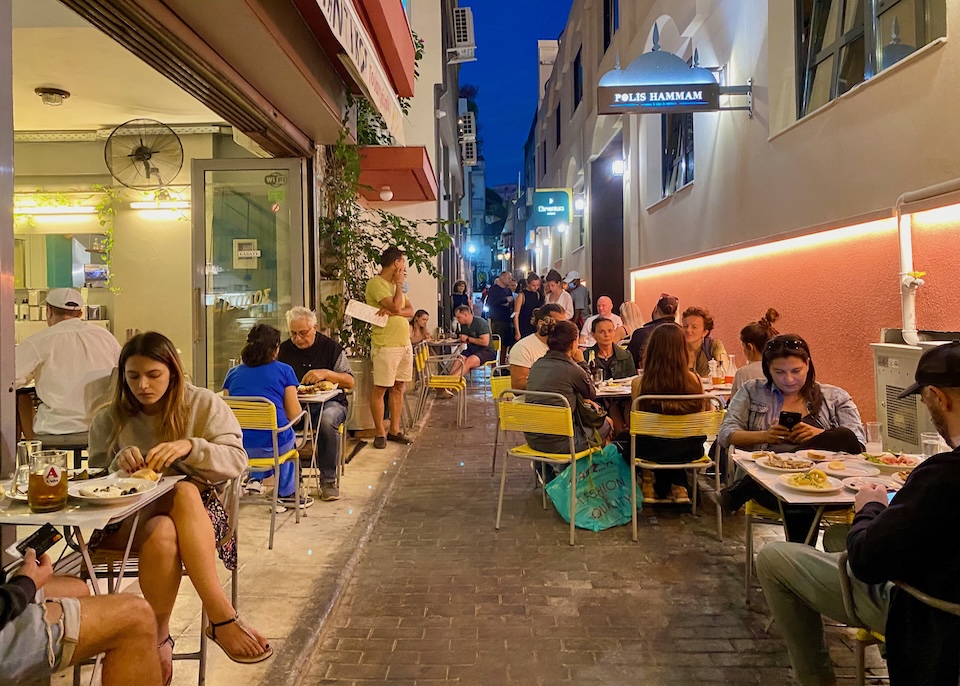
Atlantikos restaurant is right next door to Polis Hammam and serves fresh seafood until late at night.
Milos: Days 3 and 4
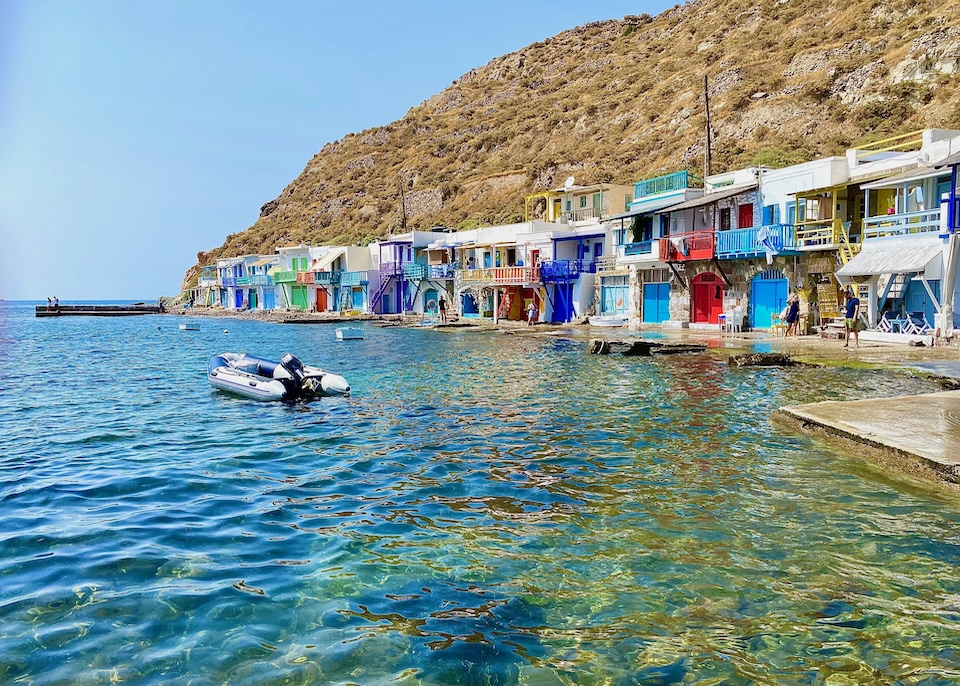
Klima village, population 8. The village is known for its colorful syrmata, some of which have been converted into rustic rooms for rent (the purple one is This Colorful Land). You can visit by car or boat.
After the hustle and bustle of Athens, Milos may feel frozen in time. Milos is one of the most relaxed islands in the Cyclades, known for its calm atmosphere, brightly painted syrmata (boathouses), and beaches shaped and colored by volcanic minerals. It’s also the island where the Venus de Milo was discovered, and where the cliffs and caves of Kleftiko once sheltered pirates. The capital, Plaka, sits on a hill with narrow whitewashed lanes, small shops, and views over the Aegean. Milos is a place to explore slowly, enjoying the beaches, seaside tavernas, and fishing villages without rushing from sight to sight.

Sarakiniko is the most famous beach in Milos, known for its unusual white rock formations. This rugged beach can get crowded in high season. There are no facilities and no shade, so pack well.
On day one, drop your bags at your hotel and head straight for the beaches. Start with Sarakiniko, the island’s most photographed spot. The smooth white rock is often compared to a lunar landscape. Walk along the ridges, climb down to the coves and bright blue water for a swim. After Sarakiniko, head south to either Fyriplaka or Thiorochio. Fyriplaka is ideal if you want a classic beach afternoon, with warm water, colorful cliffs, and plenty of space to relax. Thiorochio, on the other hand, offers something completely different. The beach sits beside an abandoned sulfur mine from the 1930s, and the shoreline is covered in copper and green pebbles. It’s not a typical beach, but the scenery is unusual and worth seeing if you like places with a bit of character and history. Borrow a beach umbrella from your hotel and pack sunscreen. There is a small beach bar at Fyriplaka during the high season, but there is not a lot of natural shade on any of these beaches.

Fyriplaka Beach in Milos has a small beach bar and watersports center, plus dramatic, multi-hued rock formations.
In the evening, head up to Plaka. Give yourself time to wander the lanes, browse the shops, and stop for a quick drink before sunset. As the light starts to shift, make your way to the Venetian Castle. The short climb rewards you with the best views on the island, stretching across the sea and the surrounding villages. Once the sun sets, walk back down into the center of Plaka for dinner. The atmosphere in the village at night is relaxed and welcoming, with people strolling, eating outdoors, and enjoying the breezy hilltop air.
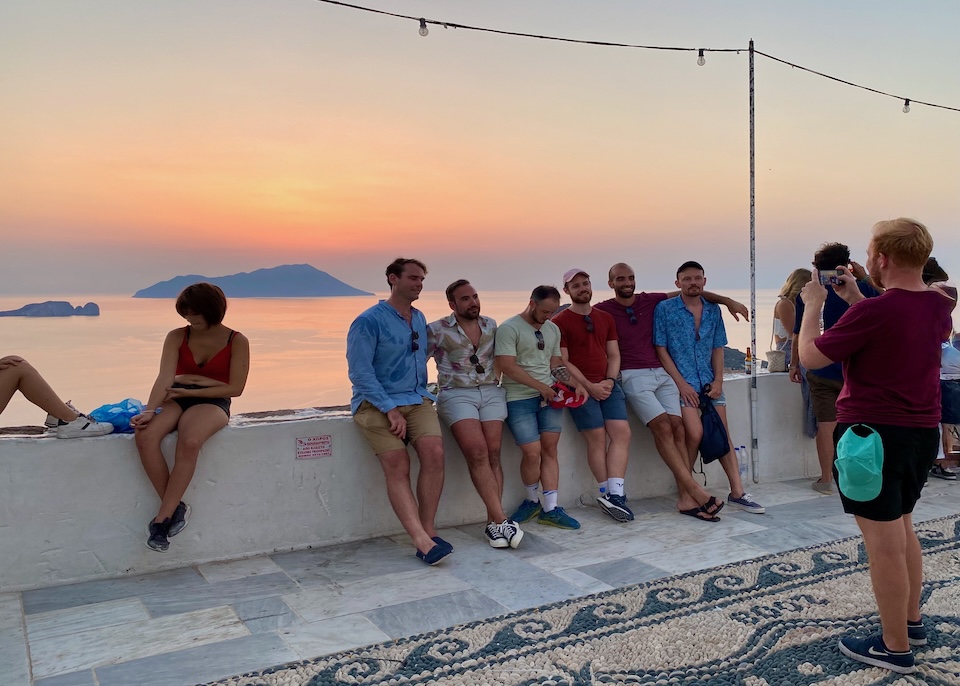
The town square behind the Church of Panagia Korfiatissa in Plaka is a popular spot for sunsets.
The next morning, head to the port village, Adamas, for a half-day boat trip to Kleftiko. This is one of the must-do experiences in Milos. You can only reach Kleftiko by water. The white rock formations rise up around a maze of sea caves and natural arches, which made it a popular hideout for pirates in the Byzantine and Ottoman eras. “Kleftes” means “thieves,” and “kleftiko” is the “place of thieves.” Most tours make several swimming and snorkeling stops, giving you time to float through blue-lit tunnels, explore the small coves, and enjoy the calm, protected bay. The water is some of the clearest and brightest in the Cyclades.
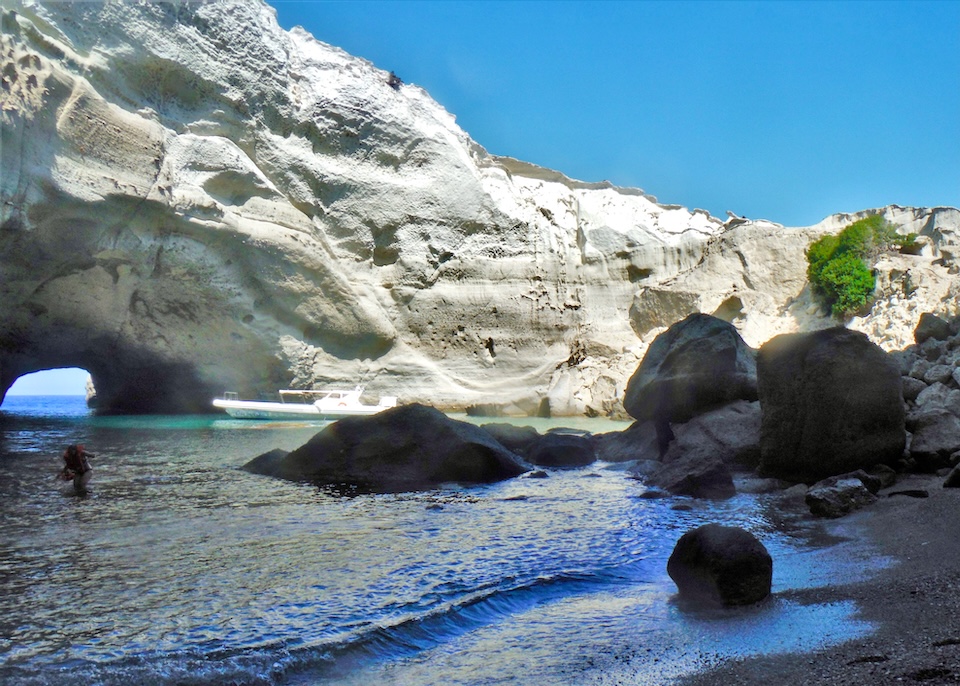
Milos is filled with hidden beaches, many accessible only by boat, like this one in Kleftiko. You can visit exactly the same places pirates used to hide themselves and their treasures.
After the cruise, take some time to relax back in Adamas. Have dinner at O! Hamos!, a local favorite known for family recipes and ingredients sourced from their own farm. The dishes are hearty, traditional, and consistently good. After dinner, stay in Adamas for a waterfront drink. The town has an easygoing nighttime buzz without feeling crowded. Alternatively, enjoy a more peaceful afternoon in Klima. The waterfront is lined with the island’s iconic syrmata, each one painted a different bright color (you most likely saw it from the sea on your Kelftiko cruise). It’s a tiny village with the water lapping at the shore just steps from the buildings. Have dinner at Astakas, the only restaurant in town, where the tables sit right at the edge of the bay. The sunset here is long and wide, and the whole village glows as the light drops behind the hills across the water.

Adamas (or Adamantas) is the port town and has a larger population than the capital, Plaka. This is a great base for short trips to the island with plenty of dining, a little nightlife, the bus hub, and easy access to the ferries and boats to Kleftiko.
Where to Stay: For short stays like this, Adamas (AKA Adamantas) is the most convenient place to make your home base. It’s where you’ll find the ferry port, boats to Kleftiko, two small beaches, wonderful seafront restaurants, and a little nightlife. But if you have some extra time and want to extend your stay, Pollonia is a better option with a long sandy beach, excellent restaurants, the best luxury and boutique hotels, and more of a resort vibe. Plaka is wonderful for a romantic getaway with great dining, sunset views, and music in the air at night. Klima is great for more adventurous travelers, who may opt to stay in one of the syrmata that have been converted into rooms for rent (often with outdoor showers). My favorite places to stay include White Pebble Suites (Pollonia), Captain Zeppos (Pollonia), and Santa Maria (Adamas). Try The Colorful Land (Klima) for a syrmata stay or Skinopi Lodge, a remote but luxurious stay.
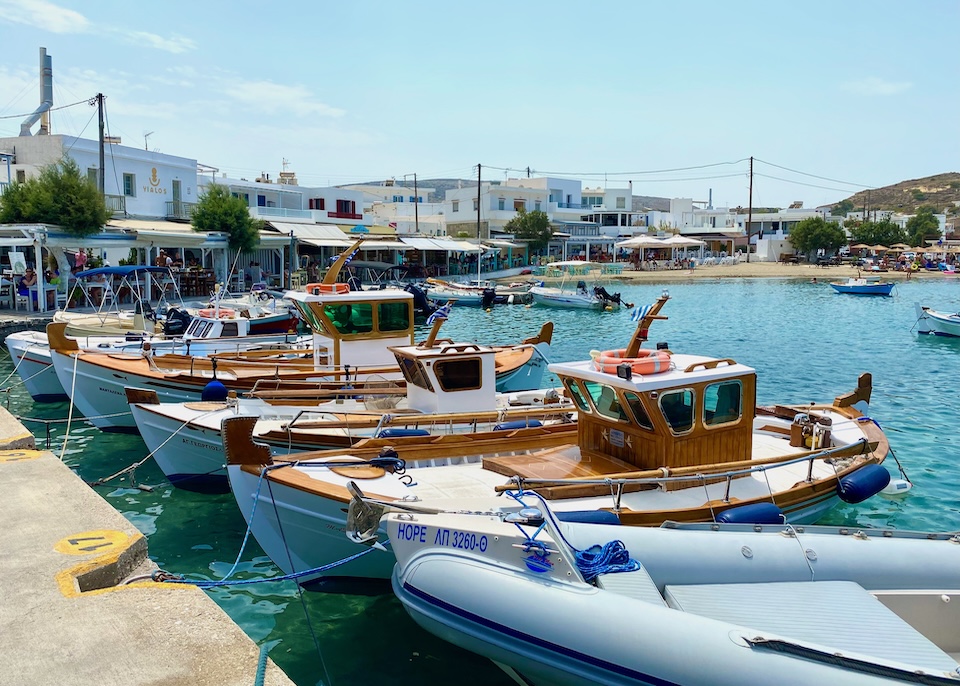
For longer stays, Pollonia is the most popular resort town, with the island’s best hotels, a sandy beach, and relaxed dining.
Where to Eat: O! Hamos! in Adamas is beloved for traditional Greek dishes and farm-fresh ingredients. In Pollonia, Enalion offers elegant seaside dining with local wines, and Kivotos Ton Gefseon is a traditional bakery for breakfast and desserts, known for their galaktoboureko (layers of phyllo and custard drenched in syrup). Kivotos Ton Gefseon also offers homemade jams and preserves made from local produce and honey, perfect for gifts. Avli Milos is my favorite restaurant in Plaka with creative Mediterranean flavors in a stylish setting. Astakas offers fresh seafood on the waterfront in Klima. Methismeni Politia is one of the best restaurants on the island, serving refined Greek cuisine with sea views from its location in Trypiti.
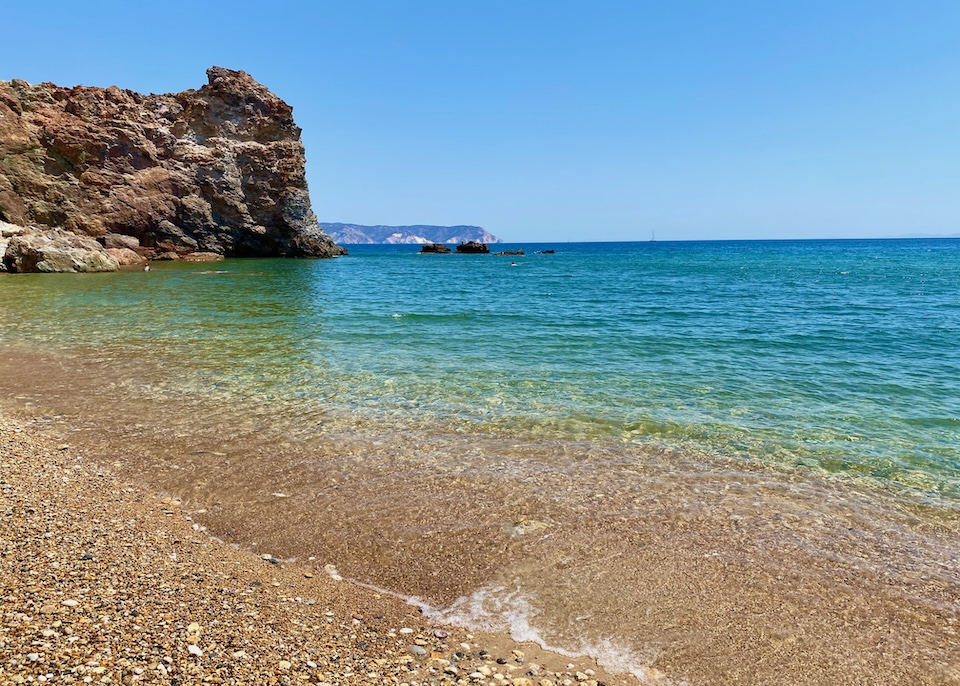
Thiorichio Beach in Milos offers calm seas and a mix of sand and pebbles on the beach. Set back from the water’s edge (not visible here), an abandoned sulfur mine from the ’30s is an interesting spot to explore.
Best Beaches: There are over 70 beaches in Milos, and narrowing down the best is no easy task. You could stay here for the full two weeks instead of visiting any other island, and you still won’t come anywhere near seeing them all. But here are some of my favorites. Sarakiniko is a must-see for its unique geomorphology. Swimming is excellent here, though there is limited sandy space; you’re mostly lying on the bedrock, which can be less comfortable for long stays. For longer beach days, Fyriplaka and Thiorochio offer more comfort, excellent swimming, and stunning scenery. Thiorochio is more rustic, while Fyriplaka is semi-organized with one beach bar in summer. Paliochori offers multicolored cliffs, warm water, and beachfront tavernas, while Provatas is a family-friendly, organized beach with calm, shallow water. Tsigrado Beach, I think, is a victim of its own fame. This is an amazing, secluded, little beach that’s accessible by holding onto a rope while climbing down a rickety ladder and going through a tunnel. But its Indiana Jones-style entrance has made it incredibly popular with tourists, and now there is often a traffic jam of people waiting to go up or down the ladders. And once you get to the beach itself, it’s jam-packed. I used to love it here, but now I say skip it. Similarly, Papafragas Caves was a cool little spot to swim in the naturally occurring sea caves without having to take a boat, but the path down to the caves is fenced off (and has been for quite a while). Strong swimmers can still reach the caves via a 20-minute swim from the main beach, but the water can be rough on windy days. I say give this one a pass, too.
Santorini: Days 5 to 7
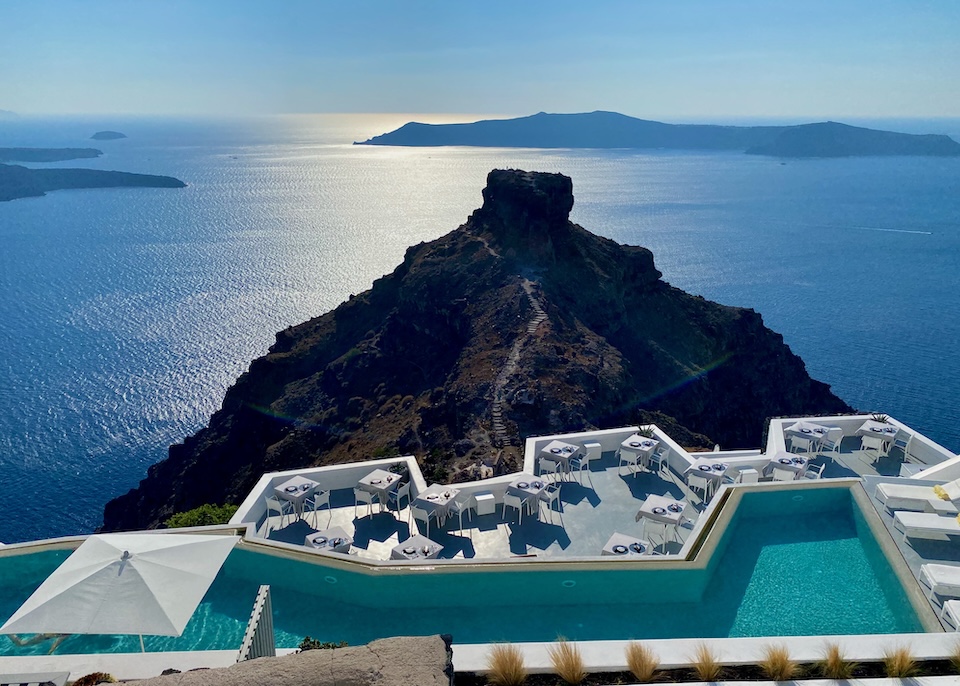
The caldera view in Imerovigli facing toward where the sun is about to set. This is the pool and restaurant at Grace hotel, the top luxury hotel on the island.
Santorini is the crown jewel of the Cyclades — a crescent-shaped island carved by lava and sea with whitewashed villages clinging to cliffs above the caldera. Its dazzling light, iconic blue domes, and golden sunsets have made it one of the most famous views in the world. Around 1600 BC, one of the largest volcanic eruptions in history blew apart the island of Thera (now Santorini), leaving behind the flooded caldera we see today. From that destruction came the island’s breathtaking landscape. The view from the top of the cliffs looking down into the caldera over the volcanoes is the main attraction of this island.
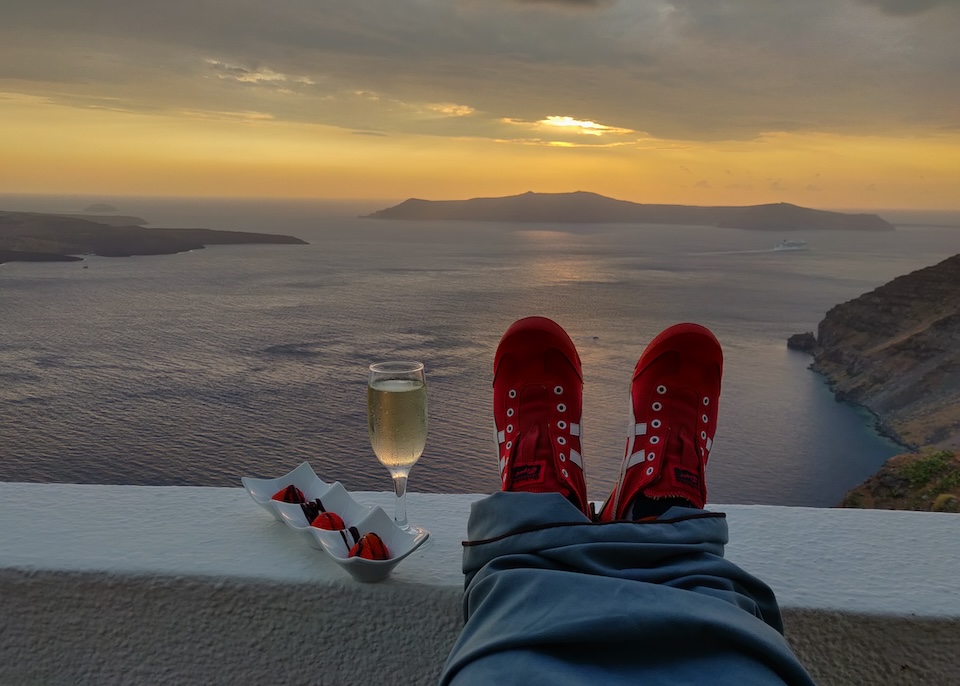
Sunset view with champagne as seen from my room at Sun Rocks hotel in Firostefani. Firostefani is the village just north of Fira, with a little more elevation and thinner crowds. Peep that blanket. Even in summer, it can get a little chilly on the cliffs. Some of the nicer restaurants offer blankets to diners, inevitably caught off guard by the sudden drop in temperature.
More than on any other stop on this itinerary, it’s 100% worth it to spend the money on a room with a caldera view with a private balcony. You’ll be spending a fair amount of time on your hotel balcony in Santorini, so treat yourself to a great one. If you can swing it, book a room with a sunset view (which means staying in Fira, Firostefani, or Imerovigli; hotels in Oia either face the caldera or the sunset, not both). And if you book a room with a caldera view and a sunset view, then why not splurge on a jacuzzi or heated plunge pool on your private balcony? You can save money by booking cheaper rooms on other islands, but don’t skimp here. Most hotels are luxury, boutique stays with breakfast served to your balcony, so you’ll begin your day with the view. Most also have evening wine or cocktail service on a communal terrace or served to your room (even if they don’t otherwise offer room service), so you can watch the sunset in tranquility, rather than vie for space at the most popular and crowded viewpoints.

Fira is the capital of Santorini. You’ll find a mix of luxury and budget hotels, restaurants, tavernas, nightlife, and attractions. Many hotels and restaurants have views of the sun setting over the caldera. This is the best place to stay if you’re not renting a a car, as this is the main bus hub of the island with routes to all villages, beaches, attractions, the port, and the airport.
The best way to begin your visit is to drop your bags at your hotel and head straight for the caldera’s edge. Whether in Fira, Firostefani, Imerovigli, Oia, or Akrotiri, the view will stop you in your tracks: steep cliffs plunging into the blue Aegean, white villages gleaming in the sunlight, and the dark volcanic islets rising from a sea dotted with sailboats and ferries. This view is Santorini’s soul; I can’t overstate it. These villages are also the best places to stay: Fira for energy and convenience, Firostefani and Imerovigli for peace and panoramic views, and Oia for its elegant charm and winding lanes.
Spend time wandering through whichever village you call home. The narrow stairways and cliffside terraces are literally designed for getting lost in (it helped protect the inhabitants when pirates raided hundreds of years ago). In Fira and Firostefani, explore small boutiques and cliffside cafés. In Imerovigli, take the short but stunning hike to Skaros Rock, the remains of a medieval fortress (one of five Venetian castle ruins on the island) jutting out into the sea. From the top, the caldera stretches endlessly in both directions, a view that defines the island’s magic. Oia’s maze of white alleys, blue-domed churches, and art galleries is just as captivating, best enjoyed early in the morning or late in the evening when the crowds thin. Afternoons can be crowded, especially in Fira and Oia.
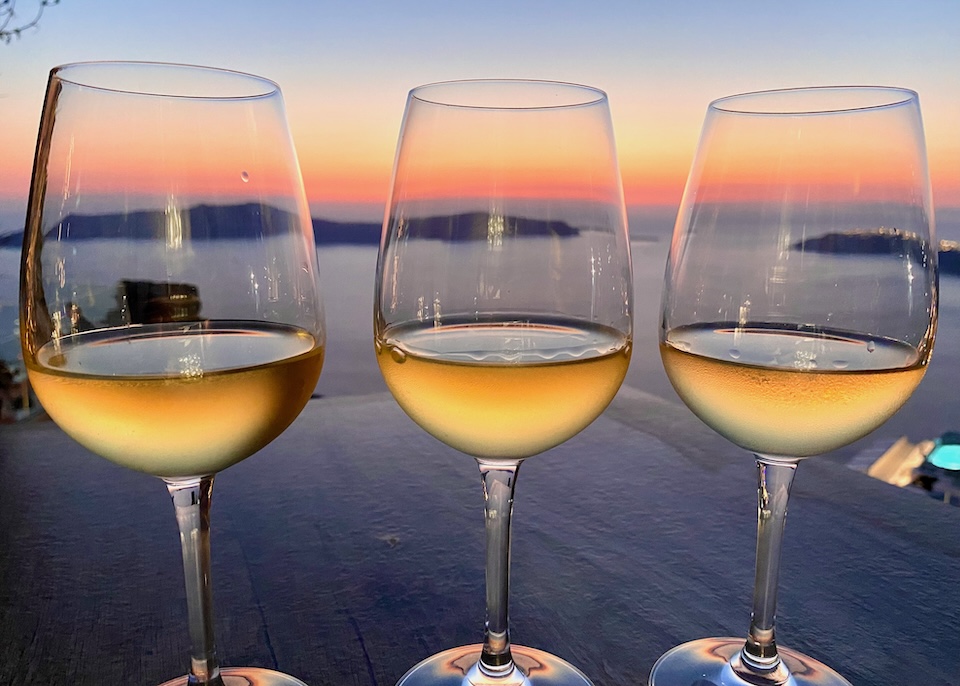
Wine and sunsets are two things Santorini does best. This is a flight of white wine, including assyrtiko and nychteri varieties, served at Athenian House in Imerovigli. Imerovigli village sits at the highest point in the caldera with direct sunset caldera views.
When evening comes, it’s time for Santorini’s most famous ritual: watching the sunset. The sunset is best enjoyed in a peaceful spot. On a first evening here, I prefer to take in the scenery from my private balcony or hotel terrace (as mentioned earlier) or reserve a table at a caldera-view restaurant or winery (Athenian House, Santo Wines, Venetsanos, Elinikon, and Ambrosia are all great choices). Another fun alternative is to pack a picnic and drive down to the Akrotiri lighthouse at the island’s southern tip with sweeping views of the caldera, sunset, and the open sea. I used to recommend taking in the sunset at the ruins of Oia’s Venetian castle, but nowadays, unless you’re visiting in winter, the crowds are completely out of control, with people shoving their way to the front with their cameras held out. If you’re short (like me), you may not be able to see anything from there, except assholes and elbows.

Ancient Akrotiri is a remarkably well-preserved archaeological site that was buried under ash for more than 3700 years. Highly advanced for its time, it is believed by many to have inspired the legend of Atlantis.
On your second morning here, visit the island’s archaeological gem. Ancient Akrotiri is a remarkably preserved Bronze Age city buried under ash during the great eruption, much like Pompeii. Some believe that Akrotiri inspired the myth of the lost city of Atlantis. Walking through its streets, you’ll see the remains of multi-story homes, pottery, and frescoes that speak to a civilization far ahead of its time. Pair this with a visit to the Museum of Prehistoric Thera, which houses the original frescoes and other treasures from the excavation site.

Instead of long, even rows of vines, wineries in Santorini train their grape vines to stay low to the ground in a basket shape, known as kouloura. This helps retain moisture in the dry climate and shields the grapes from the harsh wind and sun.
In the afternoon, visit at least one of the island’s wineries as a stop on its own or take a wine tour. The same volcanic soil that buried Akrotiri now nurtures vines grown in an unusual traditional style. Vineyards here coil the vines into a basket-shaped form called kouloura, set low to the ground to protect them from fierce winds and sun. On this desert island, irrigation is not allowed, so this shape allows the grapes to more readily retain their moisture. Wineries like Santo Wines, Art Space, or Gavalas offer tastings. Or have dinner at Oia Oenosart, a phenomenal restaurant that prides itself on carrying wine from every single winery on the island.

Once you’ve seen the caldera from above, the next step is to get down into it. Many caldera cruises begin or end in Ammoudi Bay, the port just below Oia. Ammoudi is also where you can opt to end the Fira to Oia hike. The bay is lined with fresh seafood restaurants.
Last night, you saw the sunset from above the caldera. Now it’s time to see it at eye level. In the late afternoon, take a catamaran cruise through the caldera. These half- or full-day sailing trips glide past the volcanic islets of Nea Kameni and Palea Kameni, where you can swim in mineral-rich waters and snorkel in small coves. There are some “hot” springs at the base of the volcanoes, and the boats usually stop there for a quick swim, but the water is still pretty chilly (excuse me – “refreshing”) even in summer. All tours offer wine, and many serve dinner on board, which you may savor while watching the cliffs turn golden from the deck.
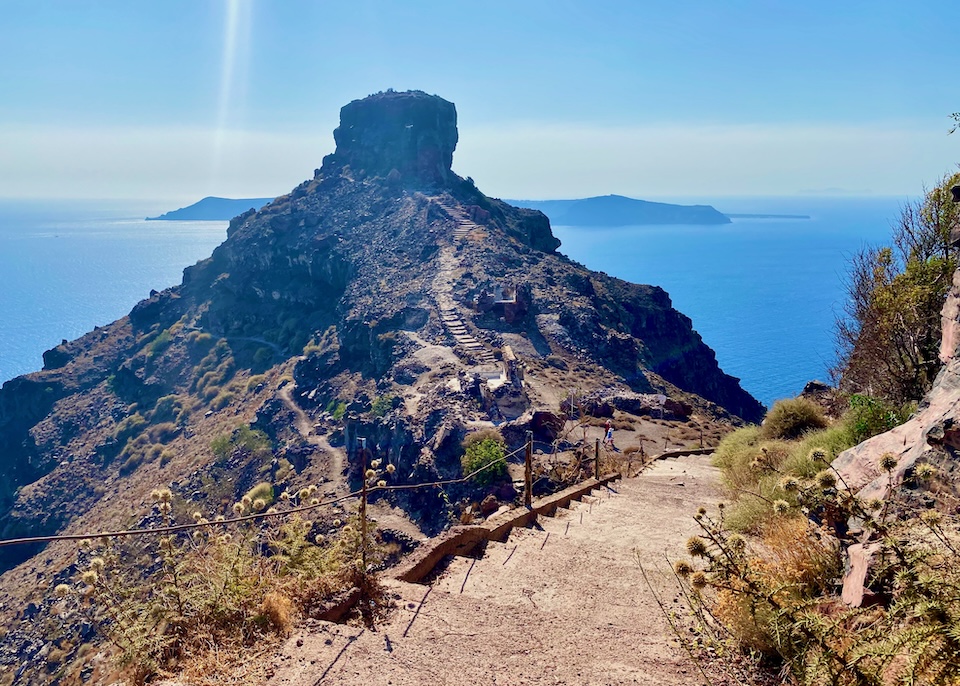
Skaros Rock in Imerovigli is topped with the ruins of a Venetian castle and has a small Orthodox church on its far side. You can make a detour here along the Fira to Oia trail if you have time; it’ll add an extra hour or so to your hike.
On your final morning, rise early for the spectacular Fira to Oia hike. This hike is part paved, part cobblestone, and part dirt trail with some elevation and dramatic views the entire way. Wear good, supportive shoes with tread; some parts of the path have loose gravel and tricky terrain. The entire hike takes 2.5 to 5 hours, depending on how many side quests, photos, and snack breaks you take along the way. Hiking from Fira to Oia includes a slightly more challenging climb (especially the portion between Firostefani and Imerovigli, the highest point on the caldera) compared to hiking the other way from Oia to Fira. But ending in Oia is best because you have some great options to cool down after the hike. You can finish at Lioyerma Pool Bar for lunch, cocktails, and a swim in Oia village. Or continue down the side of the caldera to Ammoudi Bay, where you’ll find a clutch of high-quality seafood restaurants right on the water. After lunching here, walk the path past all of the restaurants to Agios Nikolaos (St. Nicholas) Rock and take a cool plunge into the sea.

If you continue past the Ammoudi restaurants, you’ll find Agios Nikolaos. Not quite a beach, but a great little swimming spot to cool off after the big hike.
In the late afternoon, venture inland. Santorini’s traditional villages offer a slower, more local rhythm. Pyrgos is a beautiful choice, especially in the evening. The village is built around a Venetian castle and offers panoramic views across the island. As the sun goes down, lanterns flicker along the lanes, and small tavernas fill with the scent of grilled food and local wine. Emporio, the island’s largest village, is full of narrow alleys and hidden courtyards and feels almost untouched by modern life. It is very easy to get lost here, with just a few churches as touchstones. It’s best explored in the morning, as it is more residential with fewer places to stop and eat inside its medieval core. If you need flatter terrain for easy walking, strollers, or wheelchairs, Megalochori offers wide lanes, shady squares, and neoclassical houses. Its charming heart is dotted with artisan shops, boutique wineries, cafes, and churches with picturesque bell towers. Enjoy a casual dinner at a traditional taverna on your last night here. Metaxi Mas, Pentozali, Cava Alta, Roza’s, and Taverna Gero-Manolis – they will never let you down.
Where to Stay: Stay in one of the four main caldera villages: Fira, Firostefani, Imerovigli, or Oia. Imerovigli has the best views; it faces west and sits at the highest elevation on the caldera with many hotels and restaurants offering unobstructed sunset views. Fira and Firostefani are the next best spots for views; both face west but sit just a little lower than Imerovigli. Fira is the capital of the island, has the most restaurants and nightlife, and has the main bus station, making it easy to get around without a car. Oia sits on the caldera with hotels facing south toward the caldera or west toward the sunset but not both. However, Oia has the highest concentration of luxury hotels, fine dining restaurants, and high-end shopping. Fira and Firostefani have a mix of luxury, midrange, and budget hotels, while Imerovigli has primarily luxury and midrange offerings. There are virtually no bad hotels in Santorini, so don’t worry too much that you’ll choose the wrong one. My favorites in the main villages are Kivotos (Imerovigli), Athina Luxury Suites (Fira), Charisma (Oia), Oia Spirit (Oia), and Sun Rocks (Firostefani).

In Santorini, even the brewries offer an elevated experience. This is one course of a gourmet meal with craft beer pairing at Fteleos Brewery.
Where to Eat: Santorini is chock full of amazing restaurants. Often you have to choose between a great view and great food, but that’s not always the case. Some of my favorite restaurants with sunset views are Athenian House, Aris, Elinikon, and Remvi. Cava Alta and Rosemary in Pyrgos both have great sunsets over the island, but not directly on the caldera. Restaurants set away from the caldera often have better food. Some of the best restaurants on the island are Metaxi Mas (the absolute top restaurant in Santorini), Roza’s, Pentozali, and Lefkes. Great wineries and wine-centric restaurants include Santo Wines, Venetsanos, Art Space, Oia Oenosart, Aroma Avlis, and Pelican Kipos. Ftelos Brewery is an upscale craft brewery with a gourmet restaurant attached. For gyros, it’s gotta be Lucky’s in Fira, but if you’re based in Oia, Pitogyros is a close second. FalafeLAND, Veganissimo, and 5Senses are the best vegan/vegetarian options.
Best Beaches: Most beaches in Santorini are comprised of coarse, black volcanic sand that’s scorching hot under the summer sun. Perivolos is my favorite of the black beaches, with a string of nice beach clubs and tavernas on the shore. Kamari and Perissa are the most popular, especially for families. There is a water taxi connecting the two beaches, and Kamari also has an Open-Air Cinema that’s fun to visit after a day in the sun. The famous Red Beach is framed by crimson cliffs, while Vlychada is backed by pale, rocky cliffs carved by the winds. The beaches are striking to see, and on any other island, they’d be prime real estate. But they mostly face east, away from the sunset and away from the caldera. With so many other one-of-kind things to do here, I prioritize visiting other sites over the beaches.
Crete: Days 8 to 11
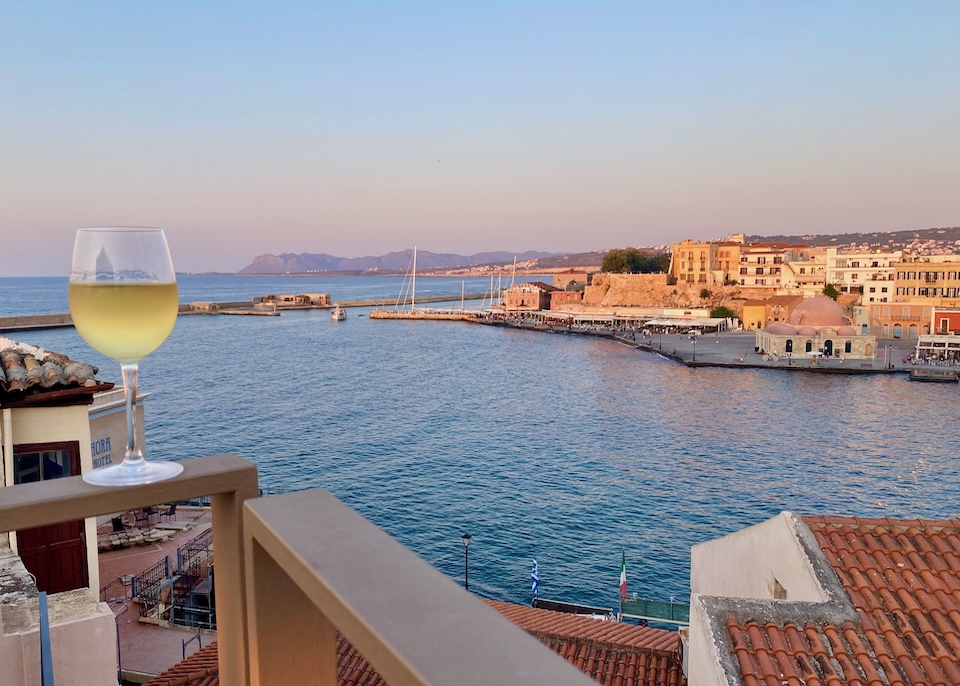
The view near sunset of the Venetian Harbor and Kiutsuk Hasan Mosque, as seen from the rooftop patio of Casa Delfino, my favorite hotel in Chania.
Crete is Greece’s largest island, a place where ancient mythology meets warm hospitality and rugged mountains tower above turquoise bays. Among Greeks, Crete is known as the country’s top culinary destination. You could easily spend four weeks here and barely scratch the surface, but with just a few days available, I like to base myself in Chania and Heraklio. These two cities offer an excellent blend of history, beaches, local flavors, and an easygoing island rhythm. This trip begins in Chania and ends in Heraklio.
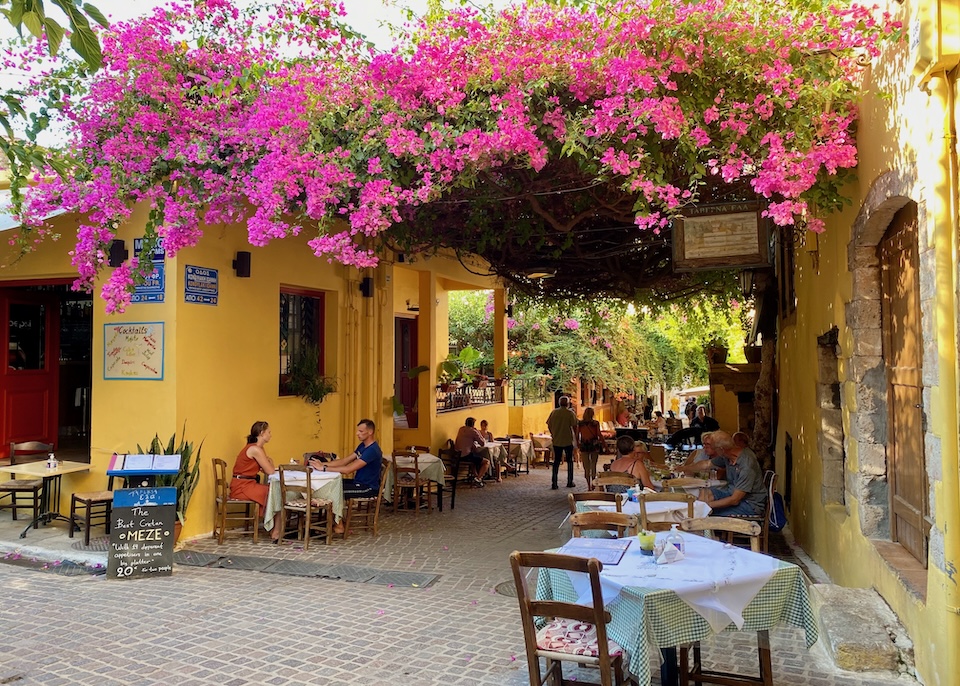
Spend time exploring the pedestrian lanes in Chania, easily Crete’s most charming village.
Chania is easily the most charming city on Crete’s northern coast. Chania’s Old Town is compact, walkable, and endlessly atmospheric. This walled 14th-century Venetian settlement has seen Minoans, Greeks, Byzantines, Arabs, Venetians, and Ottomans pass through its narrow lanes. Their legacy is reflected in the architecture: Venetian mansions stand beside Ottoman mosques, while Byzantine walls still wrap around the southern part of the ancient city. The harbor is stunning with the Firka Fortress on one side, the domed Kiutsuk Hasan Mosque on the other, and the iconic lighthouse guarding the entrance. All three landmarks were built in the mid-1600s. The fortress and lighthouses were built at the tail end of Venetian rule, while the mosque was built at the beginning of the island’s Ottoman era.

Chaina’s picturesque Venetian Harbor with its lighthouse and string of waterfront restaurants. The red building in the back is the Maritime Museum.
Drop your bags at your hotel and spend the afternoon strolling along the Venetian Harbor. Fishing boats bob in the water and seafront cafés spill onto the promenade. Explore the tangle of alleys behind the port, weaving through artisan workshops, boutiques, and tavernas tucked into old stone buildings. Stop into the Maritime Museum (built into the fortress) to get a sense of the city’s past. Or simply wander until you find a shady square, have some coffee, and people-watch. In the evening, dive straight into the island’s dynamic food and drink scene with the Sunset Craft Beer and Food Tour. Crete’s beer culture has blossomed in recent years, and these guided tastings introduce you to Greek and Cretan brewers with creative beers paired with authentic, local dishes.

Cap off your first day in Crete with a craft beer and food tour. You’ll visit notable landmarks in Chania, taste regional food, and sample a variety of Cretan and Greek beers.
The next day is a beach day. Crete’s western coast is home to some of the most spectacular in the Mediterranean. With a rental car (or on a guided tour), drive to either Balos Lagoon or Elafonisi Beach. Balos is famous for its shallow turquoise waters and photogenic sandbar that curves between the sea and the rocky Gramvousa peninsula. Reaching Balos Lagoon involves a bumpy drive and a short hike, but the reward is a beach that feels almost tropical. The beach faces north and is sometimes windy. Elafonisi Beach, farther south, is famous for its pink-tinted sand (don’t be fooled by oversaturated photos online; the sand has a pink tinge, but it’s not Pepto Bismol-colored). Elafonisi Beach has warm, shallow water, and plenty of space to spread out and relax in the sun. Both are excellent choices for a lazy beach day. Just pack water, snacks, and plenty of sunscreen. Perhaps borrow a beach umbrella from your hotel. Balos Lagoon is about an hour and a half drive from Chania, while Elafonisi is about two hours away. Of course, there are nice beaches closer to town if you prefer not to drive so far: Stavros Beach (where part of Zorba the Greek was filmed and near the paratriking meeting point), Platanias Beach (dotted with luxury resorts), Kolymvari (unassuming and relaxed), or Nea Chora Beach (about a 20-minute walk from the Old Town; plenty of tavernas and cafes here).
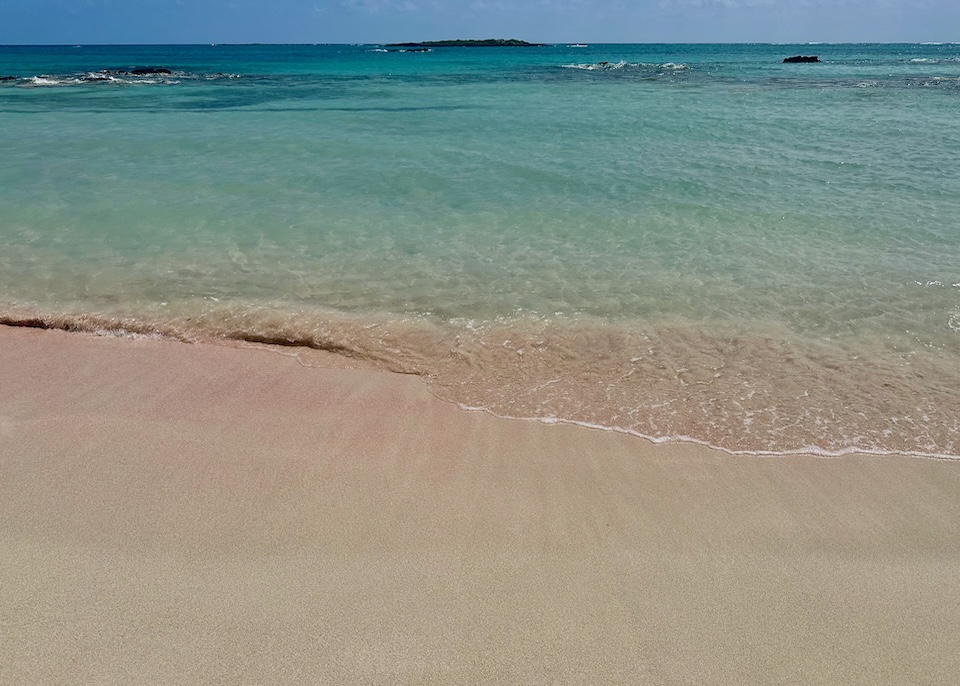
Elafonisi Beach is consistently ranked one of the best beaches in the world. Known for its (just barely) pink sand, shallow water, and waveless sea.
Return to Chania in the late afternoon and enjoy a relaxed dinner. You’ll find seafood tavernas along the water, slow-cooked lamb in tiny backstreet restaurants, and plenty of cozy wine bars pouring local varietals.
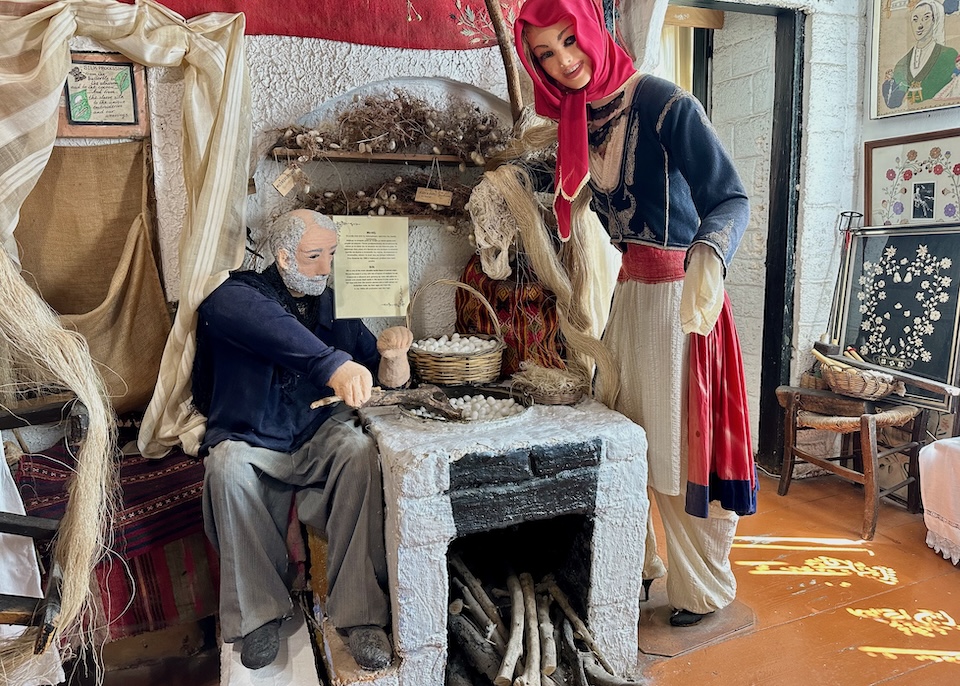
The Folklore Museum is one of Chania’s quirky, quaint museums. This one has several life-sized dioramas showing traditional activities of Cretan life.
Spend your third morning soaking up more of Chania’s charm. Stroll through the Old Town’s shops, browse small galleries, or pop into the modest museums tucked between Venetian and Ottoman-era buildings, like the quaint little Folklore Museum or the Greek National Football Team Museum. There is a lovely Archaeological Museum in the eastern part of town, as well as Koum Kapi Beach, if you want another quick dip.

Crete is known among Greeks as the country’s top culinary destination. You absolutely must take a cooking class while you’re here.
In the late afternoon, make your way inland for a Cretan cooking class in the White Mountains. These classes are hosted in small rural kitchens surrounded by olive groves and wild herbs. You’ll cook with local ingredients, like tomatoes, greens, cheeses, fresh herbs, wild honey, olive oil, and learn how to make traditional dishes like dakos, stuffed vegetables, kalitsounia, and slow-baked lamb or vegetables. Cretans are famously proud of their culinary heritage, and this evening is as much about storytelling and sharing as it is about cooking. Dinner is enjoyed outdoors over local wine with mountain views. Get to bed early-ish tonight and rest up for tomorrow. It’s a doozy.
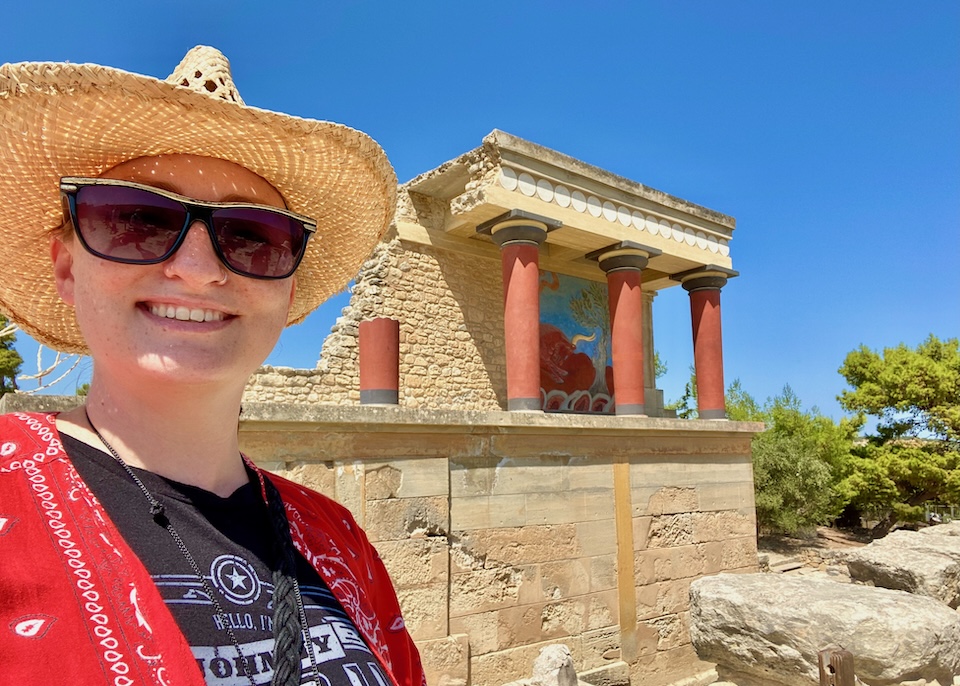
At the north entrance of Knossos Palace, the mythological home of King Minos and the Minotaur. The actual palace has no labyrinth, but it does have some controversial renstorations such as the West Bastion here with a restored bull fresco in spot that probably had a hunting fresco originally. The history of the excavation and restorations by Sir Arthur Evans in the late 1800s are almost as interesting as the site itself. Hiring a guide is highly encouraged.
The fourth morning takes you east across the island to Heraklio (AKA Heraklion AKA Iraklio), Crete’s capital and cultural center. For this portion of the trip, I highly recommend renting a car for flexibility. Get up early and drive directly to Knossos Palace (don’t worry about checking into your hotel first). The Palace, just outside the city, is the legendary home of King Minos, the labyrinth, and the Minotaur. Knossos was the ceremonial center of Europe’s oldest civilization, the Minoans, and its partially reconstructed palace gives life to frescoes, throne rooms, storage halls, and courtyards that once bustled with activity. Wandering through the site, it’s easy to imagine how the myths were born. It’s a good idea to hire a guide as signage is limited and the history of the site and of the restorations themselves is wildly interesting. Knossos Palace opens daily at 8:00 a.m. Timed entry tickets must be purchased online in advance.
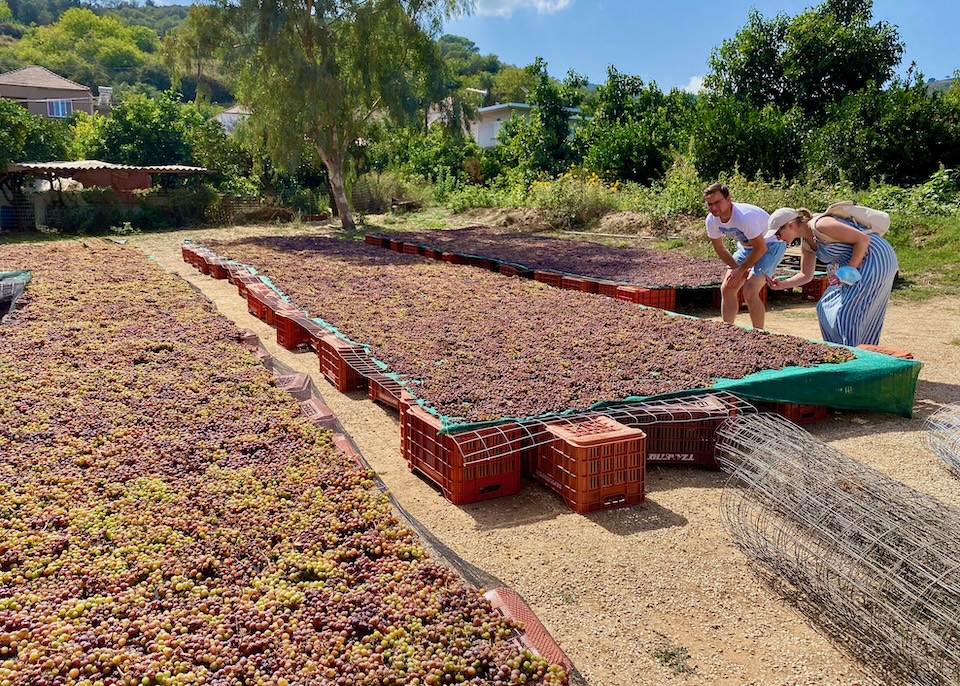
The grape harvest drying in the sun. The wine region around Heraklio is a delightful detour after Knossos. Many wineries allow drop-in tours and tastings, but booking or even just calling ahead is always a good idea.
After Knossos, let’s visit Crete’s wine country and Koules Fortress. Crete is one of the oldest wine regions in the world, with a history of viticulture going back to 5000 BC. There are at least 11 indigenous grapes here, grown alongside (and often blended with) more famous international varieties. Crete’s wine region is less than a half-hour drive from Knossos Palace. About 70% of Crete’s wine is produced in Peza, though there are only a couple of vineyards offering tastings and tours there. Nearby Arhanes also has a lot of wine varieties on offer and restaurants that have wine flights and tastings. But your best bet for visiting a winery for a tasting or tour with no prior reservations is to drive along the Stavrakion-Sivas road through the villages of Dafnes, Venerato, and Avgeniki and just pull over at any winery that catches your eye.
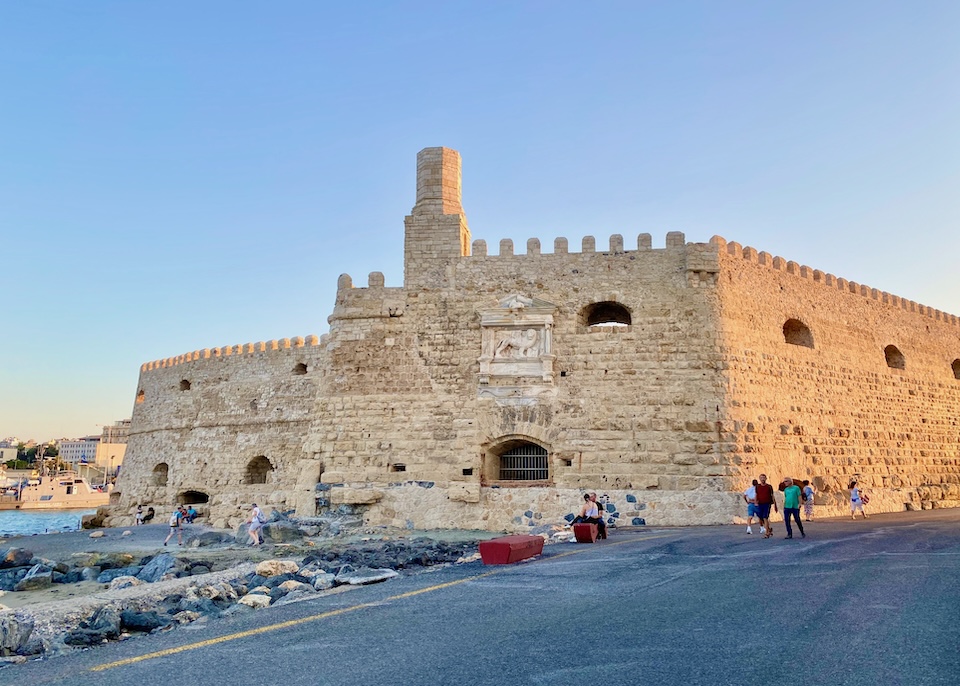
Koules Fortress, AKA Rocca a Mare, guards Heraklio’s harbor. Cretans held off an invasion for 21 years from this exact spot.
Now head into Heraklio proper. Koules Fortress (or Rocca al Mare, as it was known under Venetian rule) stands at the edge of the port and is the site of one of the longest sieges in history, when Cretans and Venetians held off the Ottoman invasion for over 20 years. The thick stone walls, sea views, and vast, echoing chambers dial up the atmosphere. There has been some type of fortification here since the 9th or 10th century AD, though the fortress standing today was rebuilt into its current form by the Venetians beginning in the 1200s and finishing in 1540. Exhibits here include the remains of ancient Minoan shipwrecks, canons and more cannonballs than you’ll ever see in the rest of your life, findings from Jacques Cousteau’s expedition, and displays on the Cretan War, which lasted from 1645-1669, ending Venetian rule of Crete and beginning the island’s Ottoman rule. Before you walk the long causeway from the mainland to the fortress with the waves crashing over the stones, know that it is closed on Tuesdays.
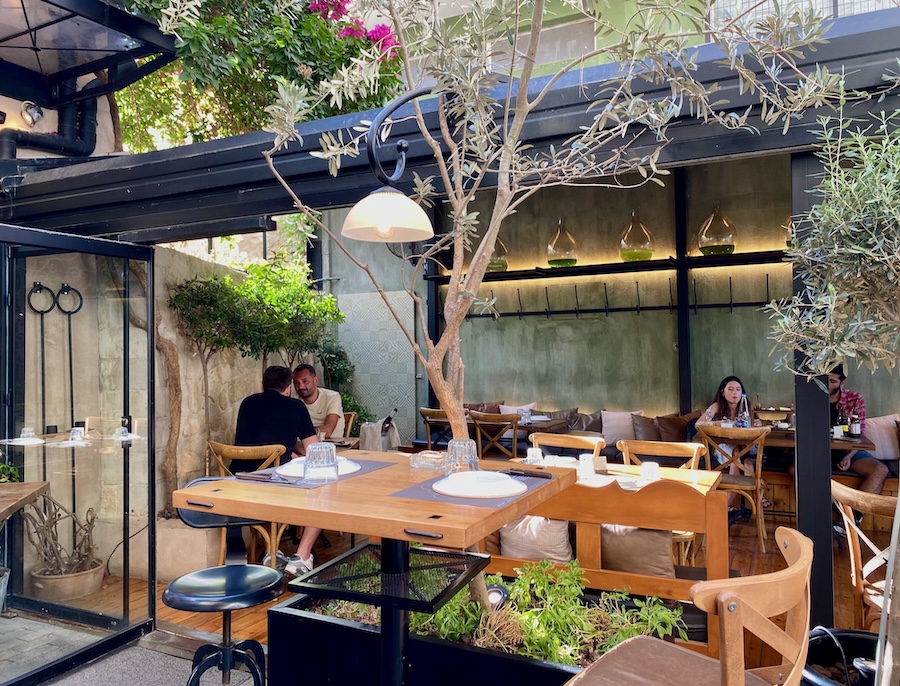
Peskesi serves modern, sophisticated Cretan food with an emphasis on local, seasonal ingredients, especially olive oil and wine. Reserve well in advance.
Though it’s not as outwardly attractive as Chania, Heraklio offers a wealth of archaeological and historic sites, spectacular dining, and vibrant nightlife. Recent urban renewal efforts have made the streets more pedestrian-friendly and lively, full of cafés, wine bars, museums, and a cosmopolitan mix of locals and visitors. Stay within the Venetian walls in the compact Old Town; everything you need is within walking distance. Heraklio really comes alive in the evenings. On your final night here, have a sophisticated Cretan dinner at Peskesi (reserve far in advance for this restaurant) or more traditional fare at Kastella, an excellent option near the water. At either restaurant, expect dishes rooted in local ingredients — wild greens, snails, cheeses, herbs from the mountains, tender meats slow-cooked in clay pots, and desserts drenched in thyme honey.
Where to Stay: In Chania and Heraklio, stay in the Old Towns, the parts of the cities inside the medieval fortifications, where you can easily walk to the main landmarks and historic sites. Some of my favorite hotels in Chania are Casa Delfino, Domus Renier, and La Maison Ottomane. My favorites in Heraklio are GDM Megaron, Legacy Gastro Suites, and Pnoe Breathing Life (this wellness resort is about 7km outside the city walls east of the airport, above the beach).
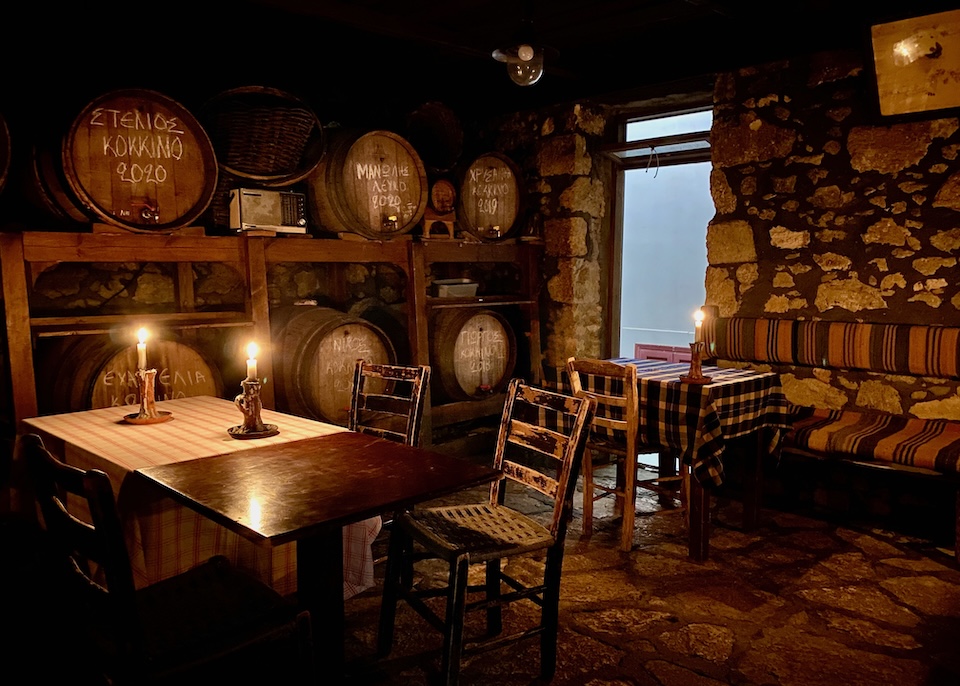
If you can’t get into Peskesi, have no fear. There are many wonderful alternatives. My favorite is Gianni’s Tavern in Kiparissos in the wine region, about a 30-minute drive from Heraklio. This is the dining room setup in the cooler months. In summer, the restaruant moves into an ancient amphitheater with dining under the stars.
Where to Eat: Crete is the premier culinary destination of Greece, offering an endless variety of amazing restaurants, grill houses, cafes, and wineries. Here is a short list of my favorites. In Chania, try Tamam, Chrisostomos, The Well of The Turk, and To Stachi (vegetarian) in town. If you’re up for a drive, Ntounias is an educational farm with an attached restaurant that is absolutely incredible. If you have extra time, they offer tours of their farm, stables, winery, beehives, and food workshops. In Heraklio, some of my faves are Peskesi, Kastella, Parasties, and Siga Siga. And if you’re up for another drive, Gianni’s Taverna in Kiparissos is a delight. It’s €25 for all-you-can-eat, fresh, local traditional food that just keeps coming relentlessly to your table. And unlimited wine that you take directly from the barrels. In the cooler months, dinner is indoors by candlelight with no electricity. In the warmer months, dining takes place outside in the Theater of the Fields, a small amphitheater with live music surrounded by farms. An absolutely magical experience.
Best Beaches: The island is enormous with hundreds of beaches, some wide and sandy with a full range of dining, drink, and hospitality services and some wild, rugged, almost inaccessible, and completely pristine. On a short trip, stick to the “greatest hits.” Elafonisi Beach is considered to be the best beach, not just in Crete but in all of Greece. But it is a long drive from the main regional hub of Chania and not worth the time sink for everyone. Balos Lagoon is a little closer, very picturesque, and great for swimming. Even closer to Chania are Stavros, Platanias, Kolymvari, and Nea Chora Beach. Bali is a gorgeous series of four beachy coves on the way to Heraklio. Matala, Palaiochora, and Plakias are fantastic south-coast beaches, which are great alternatives when the northern coast is windy.
More Notes: Crete is the largest island in Greece. Even with perfect planning, you won’t see everything in a four-day trip. When you come back (because you will want to come back) on a longer trip, you’ll have all of Rethymno, Elounda, Spinalonga, and the Samaria Gorge left to explore, along with the south coast beaches.
Rhodes: Days 12 to 14
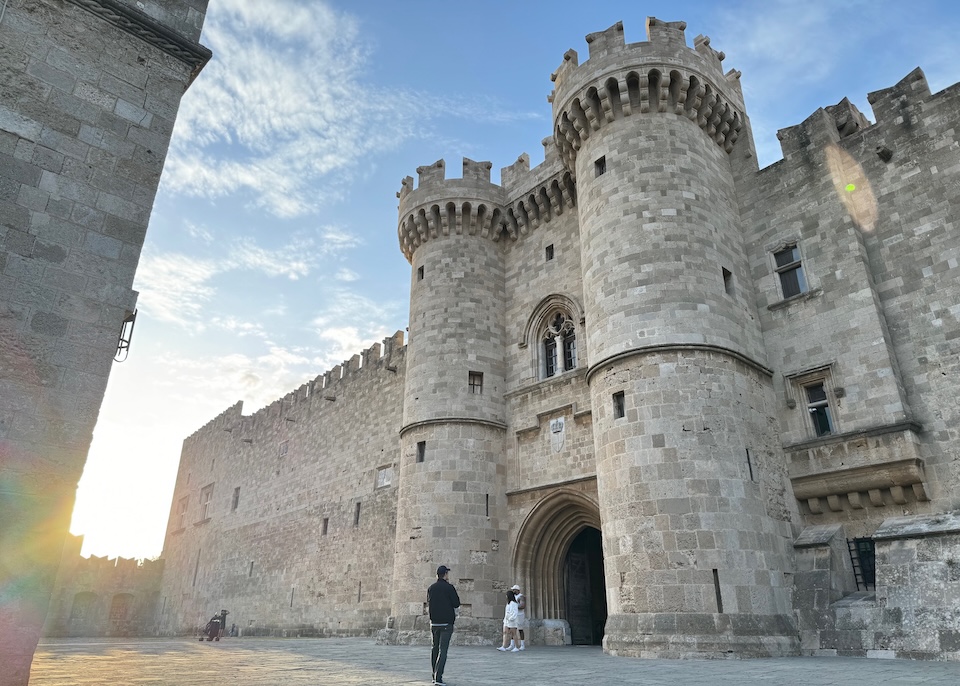
The Palace of the Grand Master of the Knights of Rhodes. This Gothic-style castle was the headquarters of the Crusader-era Knights Hospitaller.
And now for something completely different. After spending all this time in Greece, you may feel like you’ve gotten a good idea of what the country looks like overall. Well, Rhodes is here to turn those ideas on their heads. Instead of minimalistic cube houses, blue domes, and windswept cliffs, Rhodes offers monumental Gothic architecture, a well-preserved palace (complete with a moat), and a full-on medieval experience. This was the headquarters of the Knights Hospitaller of Saint John of Jerusalem. These were crusader knights, a religious military order comprised of knights from seven nations and seven languages (England, Italy, France, Germany, Aragon, Provence, and Auvergne). It still mixes Byzantine, Venetian, and Ottoman influences into Greek landscape and history, but those threads are not as overt as the crusader elements. If it’s your first time here, base yourself in Rhodes Old Town; it’s atmospheric, walkable, and perfect for exploring.
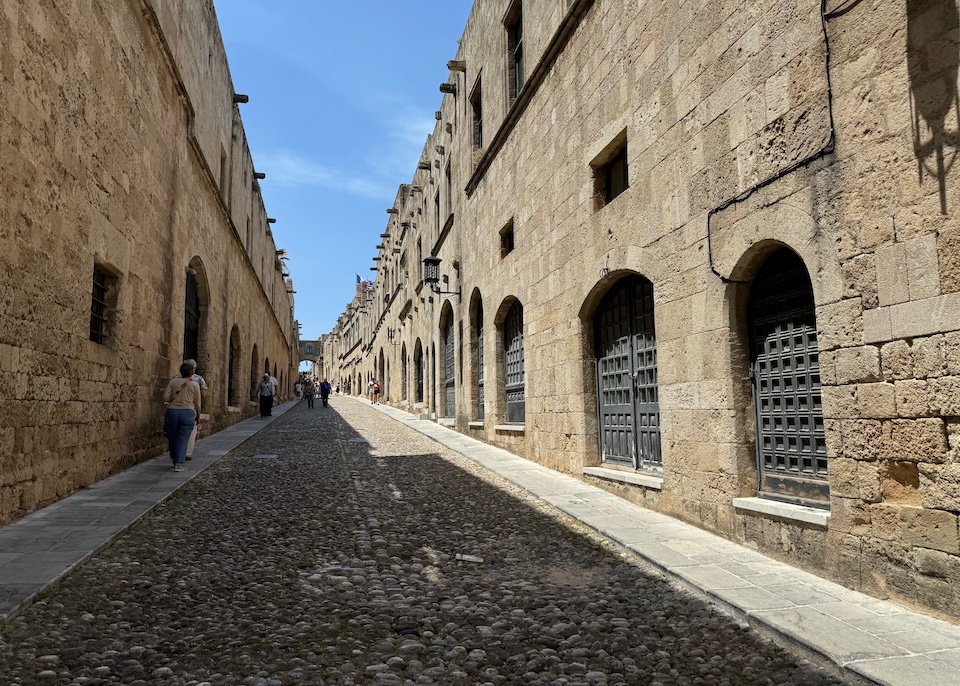
The beatifully preserved Street of the Knights cuts through Rhodes Old Town on the way to the Palace of the Grand Master and the walk that goes along the top of the medieval walls.
Arrive and dive fully into the Old Town. Start at the Palace of the Grand Master, originally a 7th-century Byzantine citadel and rebuilt into a fortress by the Knights Hospitaller in the 14th century. After exploring the rooms and courtyards, exit and walk just a few meters west to the start of the medieval wall walk. It’s about 1.5 km and takes you along the top of the fortifications with wide-open views of tiled rooftops, minarets, domes, and the sea. The walk ends at St. John’s Gate near Kókkini Porta Rossa boutique hotel. Once you’re back at street level, spend the rest of the day wandering. Just follow whichever cobblestone lane looks prettiest.

A view from the top of the fortified walls that circle the Old Town.
In the late afternoon, head out for a sunset e-bike tour (I friggin love e-bike tours). This is a great way to get the lay of the land. You’ll ride through what used to be the moat around the castle, which really shows off how massive the fortifications are. You’ll make your way up the Street of the Knights toward the Palace then cruise around the port, pass lively Hippocrates Square, and glide by the Ottoman-era Süleymaniye Mosque. The last stop on the tour is usually at the St. Nicholas Cave Church, a small Orthodox chapel carved into the hillside and lit by dozens of small candles. Outside the church, the sunset is incredible (plus you can see Türkiye across the water – it’s less than 20 km away).

Probably the coolest part of an e-bike tour is riding inside the old moat that surrounds Old Town.
Head back into the Old Town, and grab dinner at one of the open-air restaurants tucked in courtyards, on sidewalks, and between old stone buildings. The atmosphere at night is incredible.
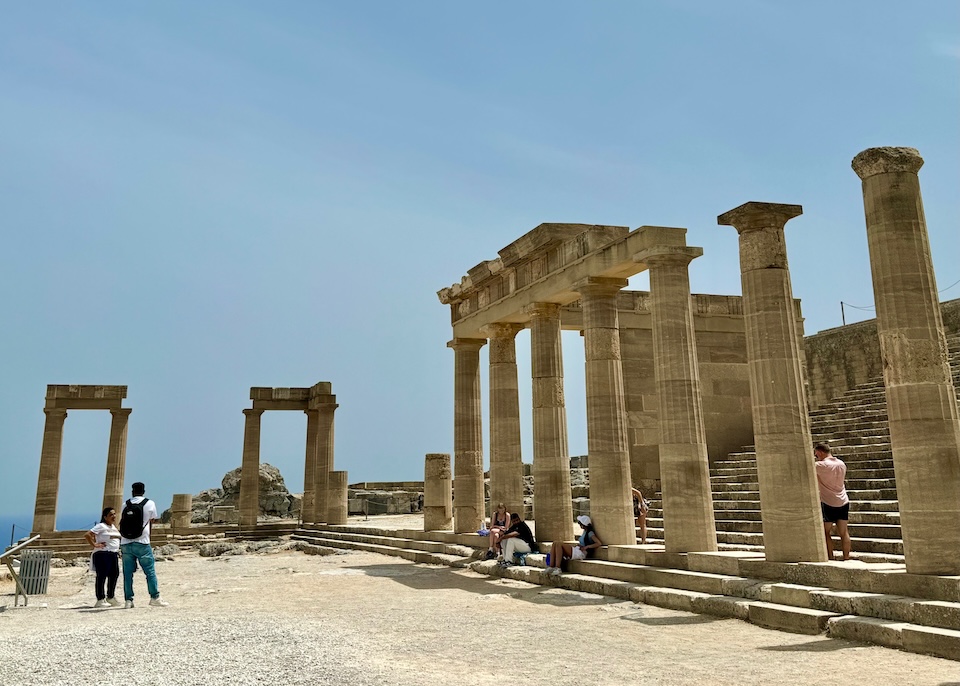
The Acropolis of Lindos is a smaller set of ancient ruins than you’ll find in Athens. But unlike Athens, the ruins here are not completely roped off. You can touch, climb, and generally interact with the ruins.
On your second morning, drive down to Lindos. The whitewashed village was built inside a natural bowl with the Acropolis towering above it. Hike up early to beat the heat. The Lindos Acropolis is much smaller than the one in Athens, but the views are more dramatic with the cliffs, sea, and the curved shape of dazzling St. Paul’s Bay below. After you make your way back down, wander the narrow lanes filled with little shops, tiny churches, and easygoing cafés.
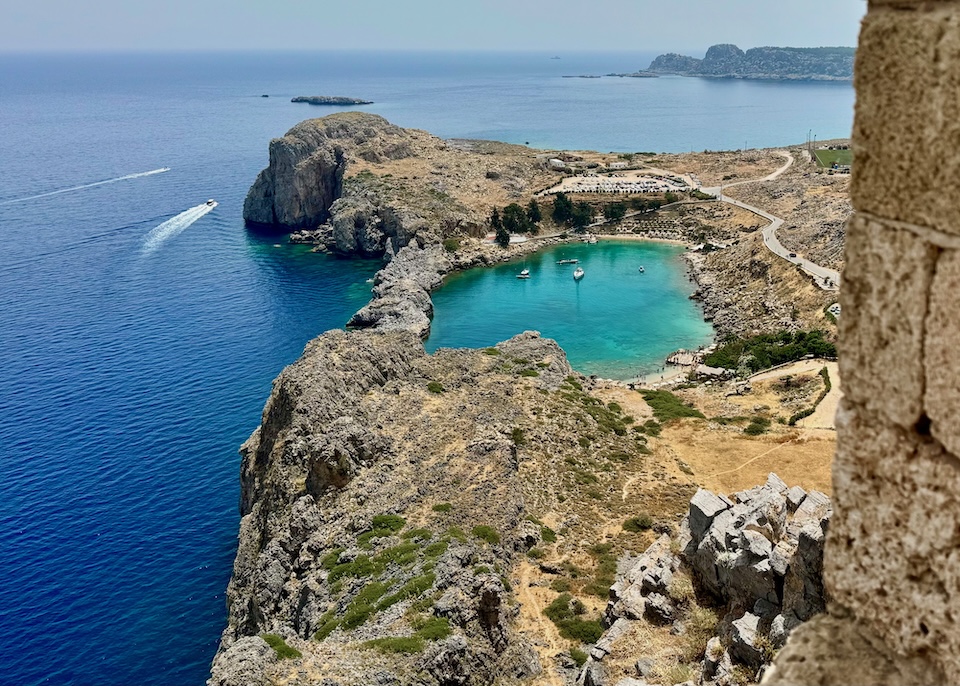
The view from the Lindos Acropolis is pretty unbeatable with dazzling St. Paul’s Bay below.
Have lunch in town or by the sea in St. Paul’s Bay. Be sure to bring your swimming gear. You can swim at St. Paul’s or stop for a swim on your way back to Rhodes Town. Anthony Quinn Bay or Faliraki Beach are two more excellent choices. Faliraki Beach has more shops and services but is a little more exposed to the wind; Anthony Quinn Bay is set in a protected cove with just a couple of beach bars (very pretty but can be crowded in high season).
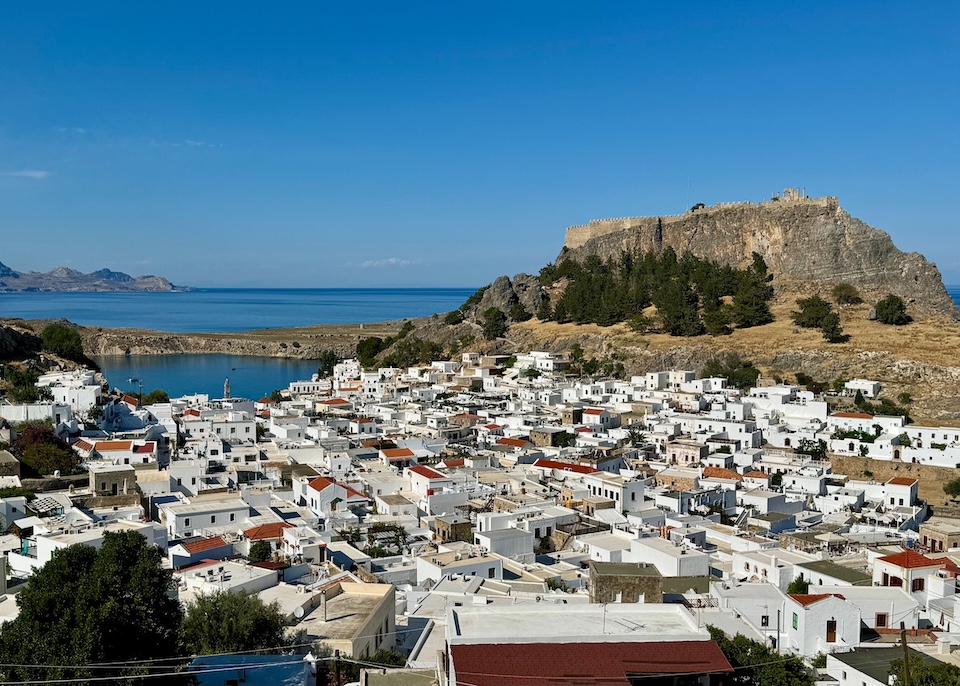
Whitwashed Lindos village below its Acropolis with Lindos Beach in the background.
The next morning is Day 14 and probably time for most people to head home. But if your flight or ferry is leaving later in the day, and you still have time to kill and the energy to do it, head up toward Ialyssos and visit Filerimos Monastery. The 15th-century Gothic church, the ruins of Ancient Ialyssos, and the panoramic views over the coast make for a really peaceful last stop before you grab your flight and head home.

If you’re not quite ready to go home yet, why not visit Filerimos Monastery? It sits above the ruins of Ancient Ialyssos and is just a short ride from the airport.
Where to Stay: There is no shortage of great hotels in Rhodes, whether you’re looking for a boutique stay in the Old Town or a beachfront resort on the coast. Here are some of my favorite places to stay: Kókkini Porta Rossa (Old Town), In Camera (Old Town), Nikos Takis (Old Town), Lindos Blu (Lindos), and Melenos Art Boutique Hotel (Lindos).
Where to Eat: So, so many great restaurants in Rhodes Old Town. Beerõkouto may be the most surprising, known for their sticky barbecue baby back ribs and craft beer. It’s not the most traditional option, but I have no regrets from spending an afternoon here. But if you’re trying to get all the famous Greek seafood you can before you leave the country, visit At Thomas. Romios offers cooks outstanding Greek-Mediterranean dishes with an over-the-top romantic ambiance. And you can’t go wrong with Hermes Greek Grill House for a meat-forward meal. Load up with a mixed grill plate. Down in Lindos, Kalypso and Village House are two amazing restaurants with rooftop seating, great wine, and views of the Lindos Acropolis.
Best Beaches: Rhodes has several excellent beaches that are easy to reach, whether you stay in the Old Town or Lindos. St. Paul’s Bay and Anthony Quinn Bay are the prettiest, and both have popular viewpoints that travelers visit beforehand to snap photos of before descending to their shores. Both are protected from the wind with calm waters and small beach clubs onsite for refreshments. Faliraki Beach is the most popular resort area, lined with restaurants, hotels, bars, and beach clubs set on the soft sands with calm water. Stegna Beach offers the more traditional Greek beach vibe: an old fishing village with a handful of casual tavernas, some sunbed sets for rent, and plenty of space to spread out your towel on the sand.
Getting To and Between the Islands
I’ve waxed poetic enough about the islands themselves, what to see, where to eat, and where to stay. So, I’ll keep this section brief. There are several guides on this very site that will tell you all the ins and outs of taking ferries, using public transportation, and renting cars with step-by-step details and photos for you to follow along. But the basics I’ll add here.
Athens
Consider an open-jaw flight. Fly into Athens from your origin city. But remember, just because you fly into Athens doesn’t mean you have to fly out of Athens. Unless you’re saving serious money by booking a round-trip ticket in and out of the same city, consider booking a one-way ticket to Athens and a one-way ticket home from Rhodes (or wherever you make your final stop). When estimating your final airfare costs, don’t forget that if you are flying round-trip to and from Athens, you’ll need to buy a ferry or plane ticket from Rhodes back to Athens, which could negate the savings of booking a round-trip ticket. It could also add considerable time to ferry back. The average Rhodes to Athens ferry costs €120 and takes 16.5 hours. Flights from Rhodes to Athens are roughly the same price as a ferry ticket, but the flight only takes an hour. If you end up having to pay for another hotel night, add that cost, too.
So, fly into Athens. The most convenient way to get from the Athens airport to your hotel is to book a private car pickup. This is true no matter where you’re flying or ferrying into. It’s always easiest to have a driver waiting to pick you and your luggage up straight from the airport/ferry port and take you directly to your hotel. I’ve never been let down by Welcome Pickups for this service, and I’ve used them all over the world (especially in Europe). The drivers monitor the flight and ferry arrivals in real time, so they are always prompt with the pickup, friendly, and helpful with loading your luggage into the vehicle. This is especially useful for families, groups, people traveling with children, people with disabilities, and people carrying lots of luggage.
Having a private pickup is the most convenient option, but it’s not the cheapest option. Fortunately, Athens is well-connected by public transit. Line 3 (AKA the Blue Line) on the Metro links Athens airport to downtown at Syntagma and Monastiraki stations from around 6 a.m. to 11:30 p.m. From there, my favorite hotels are just a short walk away. If you have a super early or late arrival, you can take the bus into town. Buses run 24/7. Look for the X95 bus, which runs every 15 to 30 minutes to Syntagma.
Once you’re in town, it’s easy to walk to most attractions from your centrally-located hotel. For sights that are farther out, the city has a robust public transit system with trains and buses linking all of the city’s most important sites. I don’t recommend renting a car to get around town, unless you want to drive to the beaches of the Athens Riviera or Cape Sounio. Traffic is congested and parking is expensive. A car is more of a burden than a boon for a short stay in Athens.
There are two ferry ports that serve Athens. When it’s time to visit Milos, you will most likely depart from Piraeus port, though some destinations leave from Rafina port. To get to Rafina port, a private transfer or taxi is best. For Piraeus port, hiring a private transfer is again the most convenient option, but the Metro is the most affordable (it can also be the fastest option during rush hour). You can get to Piraeus Port via Line 3 (Blue Line) from Evangelismos, Syntagma, Monastiraki, and Keramikos stations or take Line 1 (Green Line) if you’re staying near Omonia, Monastiraki, Thissio, or Patralona stations.
From Piraeus Port in Athens, the fastest ferry to Milos is about 2.5 hours. Flying is an option; it only takes about 45 minutes. But you’ll spend enough time getting through the airport, that it won’t save much time (if any) over taking the ferry.
Milos
Milos is a mostly rural island with a population of around 5000 spread over a handful of villages. Much of the island is rugged and uninhabited. Most people live in the port town of Adamas and the capital Plaka. If you stay in one of these towns, you can get by without renting a car; there is reliable bus service between these towns to the main beaches and points of interest: Sarakiniko, Firiplaka, Tsigrado, and Pollonia. Especially in Adamas, you can take the bus to the beaches, walk to and from the ferry, and walk to the boat to Kleftiko.
The main bus hub is in Adamas, about 100 meters from the port. All bus routes begin and end in Adamas. Service between Adamas and Plaka runs all day from 7 a.m. until midnight, routes go to Pollonia from around 7 a.m. until 10 p.m. Routes to the beaches all begin around 10 a.m. and until 6:45 or 7 p.m. Note that these are estimated times for summer bus service. Buses run less frequently (and some are nonexistent) in winter.
If you want the freedom to explore farther flung beaches, fishing towns, or the catacombs, renting a car is your best bet. If you’ve never driven in another country, this is a great place to start. Roads are free of congestion and traffic moves slowly. Some of the roads to the wilder beaches, like Thiorochio, are not in great shape, so renting a 4WD car can be helpful. But I’ve personally always rented the smallest, cheapest car available and have never had a problem the car couldn’t handle.
Welcome Pickups does not operate in Milos, but your hotel can arrange a private transfer to and from the port if you prefer not to bus or rent a car. There are also taxis available. They can be found at designated taxi stands, but there are only 15 taxis operating in Milos, so it’s best to call for ride (or have your hotel or a restaurant call for you) rather than wait at the taxi stand hoping for one to show up.
Santorini
From Milos, most ferries to Santorini cost €20 to €30 and take between an hour and fifty minutes to two and a half hours. There is an airport in Milos, but all flights have a layover in Athens, so flying will save you neither time nor money. Flights are usually €70 to €130.
As in Athens, a private transfer is the easiest way to get to and from your hotel, and Welcome Pickups does operate in Santorini. Additionally, there are about 40 taxis operating in Santorini, up from 25 just a couple of years ago. But with a few thousand hotels and Airbnbs on the island, plus thousands of cruise ship passengers visiting for the day, finding a taxi on the fly can be a task. Many taxis will be waiting at the port to pick up those who haven’t booked a private transfer, but they fill up fast, and there’s often a wait. There are also taxi stands in Fira, Oia, and popular spots like Kamari, but generally, you’ll want to call ahead to arrange a pickup. Uber is available in Santorini, but it’s usually more expensive than a taxi.
However, Santorini has a great bus system with frequent, reliable service to get you all over the island. There are always buses waiting at the port for each arriving ferry to take travelers up to the island’s capital and main bus hub, Fira. All bus routes begin and end at the Fira bus station. If you plan to get around by bus, Fira is the best place to stay. Firostefani is also convenient, as it’s a short walk (about 1 km) from there to the Fira bus station. If you stay in Oia or Imerovigli, getting to and from Fira is easy. But to go to any other village or beach, you’ll have to bus into Fira first, then take a second bus to reach your destination. I know it sounds like a hassle, but connections are frequent and smooth in the main four caldera villages and the most popular beaches, Kamari and Perissa. Waits only really get long if you’re visiting some inland traditional villages like Pyrgos or a distant beach like Vlychada. For those destinations, either drive yourself or arrange a taxi.
Driving is Santorini is a little more stressful than Milos. There is more traffic, less parking, and more pedestrians, scooters, and ATV riders to be on the lookout for. But the roads are mostly in good repair, and their winding, narrow shapes mean cars must take it slow. If you want to rent a car, do so well in advance, especially if you need an automatic transmission. There are more people who want to drive than there are available cars. It is not necessary to rent a 4WD vehicle to get anywhere in Santorini.
When I visit Santorini, I use a combination of walking, busing, and driving to get around. Walking between Fira, Firostefani, and Imerovigli is not only simple and easy, but if you take the path along the caldera with it’s amazing views, it’s also a pleasure. Buses are convenient to get to and from Oia without having to deal with limited parking and the bottleneck of traffic at the entrance to the village. Renting a car is great for visiting off-the-beaten track spots like the Akrotiri lighthouse, Exo Gonia (where Metaxi Mas restaurant is), or for getting to some of the wineries.
Crete
There is a ferry port in Chania, but currently, no ferries from Santorini use this port. Most ferries from Santorini arrive and depart from Heraklio, though there are some that use the Rethymno port. The ferry from Santorini to Heraklio takes about two hours, and the drive from Heraklio to Chania takes about two hours, making this a four-hour trip (longer if you take the bus). The ferry from Santorini to Rethymno takes about two hours and fifteen minutes, and the drive from Rethymno to Chania takes about an hour, making this a three-hour and fifteen-minute trip (again, it’s a little longer if you take the bus). Ferries are usually around €80 to €90.
Alternatively, you can fly from Santorini to Chania, but there are no nonstop flights. All have a layover in Athens. Total travel time is around three to three and a half hours. Flights are around €100 to €140. A flight won’t save you much time or money, but it will save you from having to drive all the way across the island. Though the drive isn’t very difficult. Roads and highways in Crete are modern and in good condition, with some exceptions in very rural, mountainous areas.
Once you are in Chania, you will not need a car. If you’re staying in the Old Town, there are plenty of tavernas, attractions, and nightlife just steps from your door. In summer, there is a public bus to Elafonisi Beach that leaves Chania in the morning and returns in the afternoon; it makes one trip a day. If you miss the return bus, you’ll have to stay overnight in Elafonisi (or pay about €200 for a taxi back). The easiest way to get from Chania to Elafonisi and back is to book a tour. Some tours provide lunch or stop at multiple beaches along the way. Personally, I prefer to drive myself to Elafonisi, so that I have the freedom to come and go whenever I like and make stops along the route to any interesting-looking places, like the Cave of Agia Sofia with a little Orthodox chapel inside.
For the last day here, going from Chania to Heraklio, I strongly recommend renting a car, even if you haven’t rented one on the trip so far. This will give you the time and flexibility to visit Knossos and the wine region before heading into town to visit the fortress. I don’t know of any organized tours that combine these activities originating in Heraklio, let alone originating in Chania. But if you are strongly opposed to driving, you can book a tour to Knossos Palace that begins in Chania, take your luggage on board (of course, contact the tour operator to let them know ahead of time that you’ll have luggage), and after the Knossos tour is over, remain in Knossos rather than returning to Chania. From there, you can call a taxi or take the bus into Heraklio to drop off your bags and go to visit Koules fortress. This is totally doable and affordable (as you’re not paying for a rental car or for overnight parking at your hotel), but you will be missing the wineries.
Once you’re in Heraklio, if you’re staying in the Old Town, you won’t need a car. All restaurants, museums, and attractions in the walled city are within a short walk. You can easily take a bus, taxi, or private transfer to get to the airport for your flight to Rhodes.
Rhodes
You’ll definitely want to fly to Rhodes. Ferries from Heraklio to Rhodes range from 10.5 to 14 hours; normal seats are around €30 but if you want a cabin with a bed, it’ll be closer to €80 per person.
Nonstop flights are available and take about an hour, but most flights include a layover in Athens, which makes your total travel time closer to three and a half or four hours. Flights in summer are around €60 to €130. Still affordable and way faster than a ferry.
From the airport, I recommend booking a private transfer. Welcome Pickups is available Rhodes and can take you straight to your hotel in the Old Town. This is the best option if you are carrying luggage, as all of Old Town is for pedestrians only. Rental cars are not allowed inside the city walls, so you’ll have to find a parking lot somewhere near whichever city gate is closest to your hotel and walk the rest of the way. Likewise, if you take a bus from the airport to town, it will stop in Niohori (New Town), and you’ll have to walk the rest of the way to your hotel (it’s not a bad walk, just 10 to 20 minutes, but it can feel like a lot if you’re weighed down with suitcases and souvenirs). Welcome Pickups, taxis, and a few other private transfer companies have special permits that allow them to drop travelers off directly at their hotels, so you can arrive feeling alive.
Once you are in the Old Town, you will not need a car to get around. You can walk completely across the widest part of Old Town in under 20 minutes. If you pick a centrally located hotel, all the restaurants, attractions, and shopping are at your feet. For those with limited mobility, look for the little golf carts you’ll see buzzing around town that say “Rodos Public Transport.” This is a free service that anyone can hop on for short distances inside the Old Town. Do tip the driver.
Rhodes has two companies operating public buses here: KTEL (the same company you’ve seen in Milos, Santorini, and Crete) and another company called RODA. Both bus companies have their main bus stations on Averof Street in Niohori. KTEL runs down the east coast from Rhodes Town to Faliraki, Lindos, Gennadi, and Prasonisi at the southern tip. RODA serves the northern and western coasts, passing through Ixia, Ialysos, and Monolithos. RODA also has a line to Faliraki Beach. If you’re staying in Old Town or Niohori, it only takes one bus to get anywhere on the island.
Taxis are another option for getting to more distant beaches or attractions outside Old Town. You can schedule a pickup or find the taxi stands outside the city gates near Mandraki port or Thermai Park.
Of course, renting a car and having your own wheels gives you more flexibility to customize your routes. But like Old Town, Lindos is also 100% pedestrianized, so you’ll have to park outside the village and walk from there to get to the Acropolis, restaurants, and other sites. In my opinion, if you’re based in Old Town and just visiting Lindos, it’s not worth the hassle to rent a car if you have to find parking and walk all that way anyhow. Might as well take a bus or taxi. If you plan on exploring more remote parts of the island like Embomas (the wine region), Moni Thari Monastary, or Fourni Beach, then a car is worth it. So, I guess you’ll have to come back for a longer trip to do those things next time

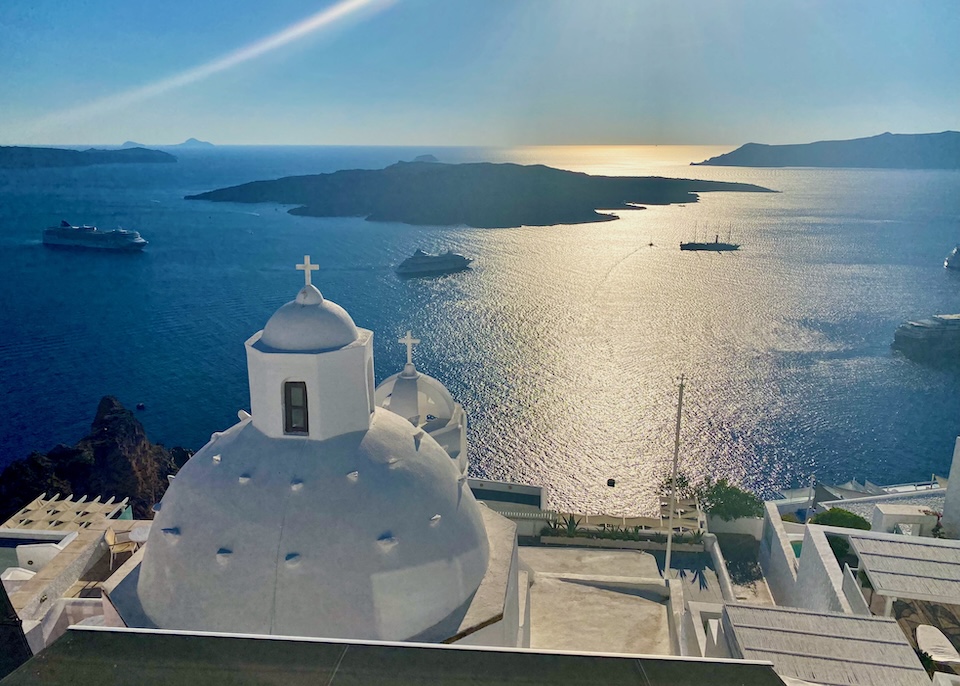

About Santorini Dave